Attached files
| file | filename |
|---|---|
| GRAPHIC - PDF VERSION OF FORM 10-K - DENMARK BANCSHARES INC | r10k2010.pdf |
| 10-K - FORM 10-K - DENMARK BANCSHARES INC | r10k2010.htm |
| EX-21 - DENMARK BANCSHARES INC | ex21.htm |
| EX-23 - DENMARK BANCSHARES INC | ex23.htm |
| EX-11 - DENMARK BANCSHARES INC | ex11.htm |
| EX-31 - DENMARK BANCSHARES INC | ex312.htm |
| EX-31 - DENMARK BANCSHARES INC | ex311.htm |
| EX-32 - DENMARK BANCSHARES INC | ex321.htm |
DENMARK BANCSHARES, INC.
EXHIBIT 13.1
Annual Report to Shareholders for the Fiscal Year Ended December 31, 2010
PRESIDENT'S LETER
To Our Shareholders
We are pleased to present to you the 2010 annual report, which details a remarkable turnaround in both profitability and asset quality as compared to last year's results. You'll notice in the pages to follow how the enhanced risk management practices implemented during the last few years have contributed to the improved results. The most notable improvement comes in the form of substantially lower charge-offs which resulted in a large decrease in the provision for credit losses and directly led to an increase in net income of more than 290%. We have also successfully managed interest rate risk and have experienced very little fluctuation in net interest income during the last three years ranging from a low of $14.5 million to a high of $14.6 million. Control of noninterest expense was also a priority, as 2010 noninterest expenses are lower than those incurred five years ago. Noninterest income reached an all-time historic high of $2.1 million in 2010.
Our impressive improvement can be linked to the successful implementation of our strategic plan. We made a commitment that asset quality improvement would be our number one priority. We kept that commitment by implementing lending policies with more stringent underwriting guidelines. We continued aggressively collecting delinquent loans and disposing of acquired properties. The focus on quality first, then profitability and lastly growth in new credits and a bank-wide effort to improve asset quality has produced the desired results.
During these historic times in the banking industry, and the lingering effects of the Great Recession, we are pleased to have maintained our superior leverage capital ratio of 13.5% which remains very strong compared to our peers. We would also like to highlight our ability to maintain your dividend payout, in a time when many of our "too big to fail" and community bank competitors have decreased or stopped their dividends all together.
We look toward 2011with the understanding that we will be faced with challenges along the way due to continued economic uncertainty in the housing, commercial real estate and agricultural markets. The new regulatory environment, which is meant to address the problems brought on by Wall Street firms and large financial institutions, will also prove challenging in 2011. Community banks did not cause the recession, however the regulatory environment will have an impact on the profitability of community banks with increased costs of compliance and staffing. The challenge remains to continue the improvement and then sustain the asset quality through the next down credit cycle but we are satisfied with the improvement during this weak economic environment.
As you know, Denmark State Bank has been serving customers in Northeastern Wisconsin for the past 102 years. As a locally owned and managed community bank we are dedicated to continue the tradition of local servicing and local decision making. As community bankers we understand that our customers are our greatest asset. We rely on knowing our customers and helping them manage their relationships through good as well as difficult economic times. We are excited to continue our commitment and support of the local communities that we serve.
Your local management team is committed to the implementation of our strategic plan which will ensure our continued success and profitability by focusing on asset quality improvement, development of our team, growth and technology. We are also committed to embracing our important and unique role as a local community bank. Community banking is what Denmark State Bank does, it is who we are every day. This year's annual report highlights this important message. We look forward to a bright future in partnership with our shareholders, customers and community.
Thank you for your confidence and as always your continued support.
Jack Olsen Jill Feiler
CEO and President President
Denmark Bancshares, Inc. Denmark State Bank

5
TABLE OF CONTENTS
|
President's Letter |
1 |
|
Selected Financial Data |
5 |
|
Report of Independent Registered Public Accounting Firm |
7 |
|
Management's Report on Internal Control Over Financial Reporting |
8 |
|
Consolidated Financial Statements |
9 |
|
Notes to Consolidated Financial Statements |
13 |
|
Management's Discussion and Analysis |
36 |
|
Directors and Executive Officers |
55 |
|
Quarterly Financial Information |
56 |
|
Denmark Bancshares, Inc. ("DBI"), headquartered in Denmark, Wisconsin, is a diversified one-bank holding company. Denmark State Bank ("DSB"), DBI's subsidiary bank, offers six full service banking offices located in the Villages of Denmark, Bellevue, Maribel, Reedsville, Whitelaw and Wrightstown, serving primarily Brown, Kewaunee, Manitowoc and Outagamie Counties. DBI also extends farm credit through its subsidiary Denmark Agricultural Credit Corporation ("DACC"). |
6
REPORT OF INDEPENDENT REGISTERED PUBLIC ACCOUNTING FIRM

Report of Independent Registered Public Accounting Firm
Board of Directors and Stockholders
Denmark Bancshares, Inc.
Denmark, Wisconsin
We have audited the accompanying consolidated balance sheets of Denmark Bancshares, Inc. and Subsidiaries as of December 31, 2010 and 2009, and the related consolidated statements of income, changes in stockholders' equity, and cash flows for each of the years in the three-year period ended December 31, 2010. These financial statements are the responsibility of the Company's management. Our responsibility is to express an opinion on these financial statements based on our audits.
We conducted our audits in accordance with standards of the Public Company Accounting Oversight Board (United States). Those standards require that we plan and perform the audit to obtain reasonable assurance about whether the financial statements are free of material misstatements. The Company is not required to have, nor were we engaged to perform, an audit of its internal control over financial reporting. Our audit included considerations of internal control over financial reporting as a basis for designing audit procedures that are appropriate in the circumstances, but not for the purpose of expressing an opinion on the effectiveness of the Company's internal control over financial reporting. Accordingly, we express no such opinion. An audit includes examining, on a test basis, evidence supporting the amounts and disclosures in the financial statements. An audit also includes assessing the accounting principles used and significant estimates made by management, as well as evaluating the overall financial statement presentation. We believe that our audits provide a reasonable basis for our opinion.
In our opinion, the consolidated financial statements referred to above present fairly, in all material respects, the financial position of Denmark Bancshares, Inc. and Subsidiaries at December 31, 2010 and 2009, and the results of their operations and their cash flows for each of the years in the three-year period ended December 31, 2010, in conformity with accounting principles generally accepted in the United States.
Wipfli LLP
February 22, 2011
7
MANAGEMENT'S REPORT ON INTERNAL CONTROL OVER FINANCIAL REPORTING
The management of Denmark Bancshares, Inc. ("DBI") is responsible for establishing and maintaining adequate internal control over financial reporting. DBI's internal control system was designed to provide reasonable assurance as to the reliability of financial reporting and the preparation and presentation of the consolidated financial statements for external purposes in accordance with generally accepted accounting principles.
All internal control systems, no matter how well designed, have inherent limitations. Therefore, even those systems determined to be effective can provide only reasonable assurance with respect to financial statement preparation and presentation.
DBI's management conducted an assessment, including testing, of the effectiveness of its internal control over financial reporting as of December 31, 2010. In making this assessment, DBI used the criteria set forth by the Committee of Sponsoring Organizations of the Treadway Commission (COSO) in Internal Control - Integrated Framework. Based on this assessment, DBI's management believes that, as of December 31, 2010, DBI's internal control over financial reporting is effective based on those criteria.
This Annual Report on Form 10-K does not include an attestation report of DBI's registered accounting firm regarding internal control over financial reporting.
Because of its inherent limitations, internal control over financial reporting may not prevent or detect misstatements should they occur. Also, projections of any evaluation of effectiveness to future periods are subject to the risk that controls may become inadequate because of changes in conditions, or that the degree or compliance with the control procedures may deteriorate.
![]()
![]()
John P. Olsen Dennis J. Heim
CEO and President CFO and Vice President
8

9
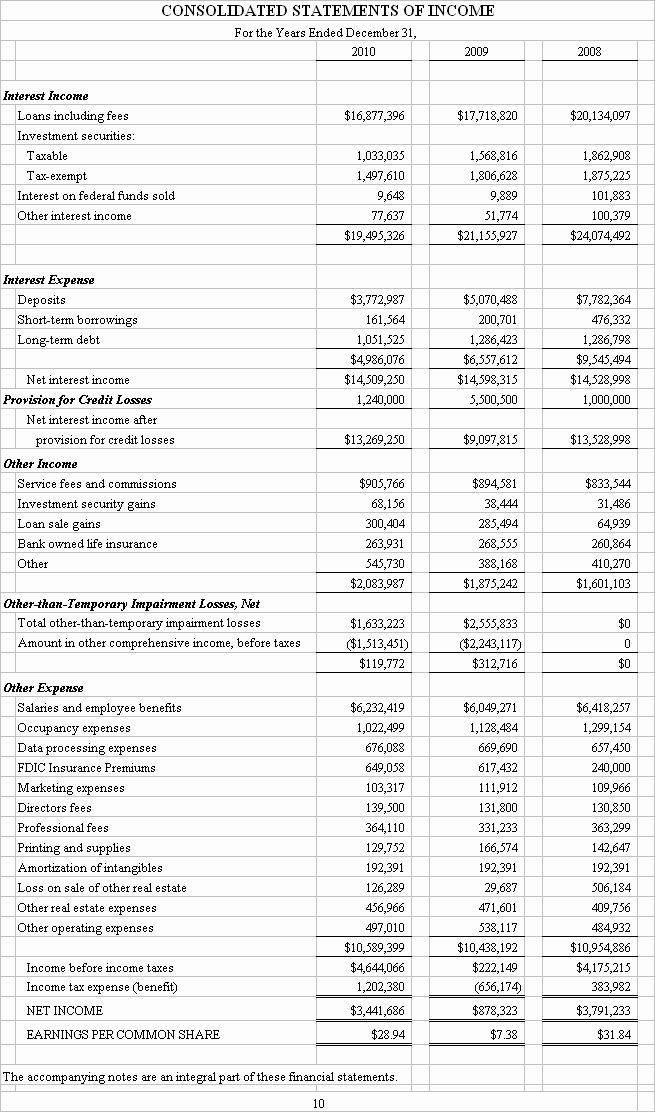

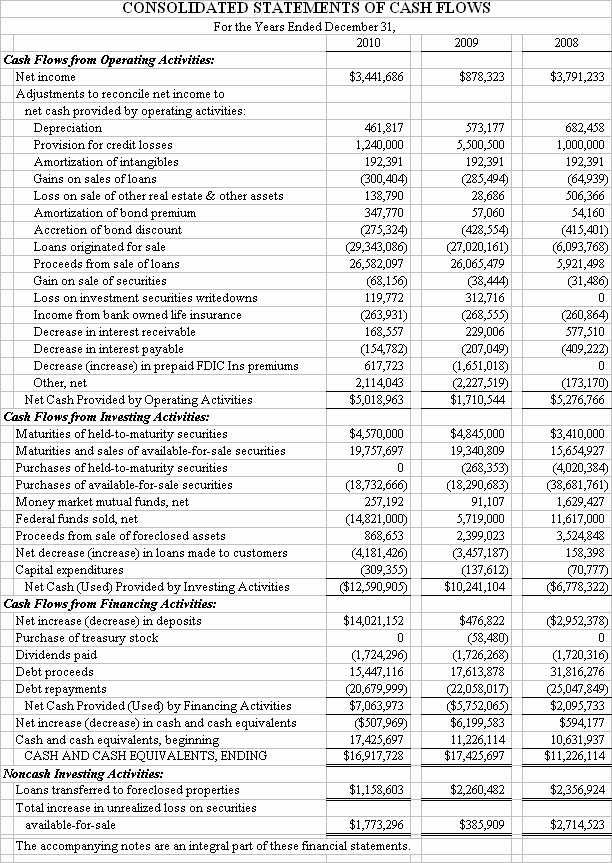
12
NOTES TO CONSOLIDATED FINANCIAL STATEMENTS
NOTE 1 - SUMMARY OF SIGNIFICANT ACCOUNTING POLICIES
Nature of Organization
Denmark Bancshares, Inc. ("DBI") is a bank holding company as defined in the Bank Holding Company Act of 1956, as amended. As such, it exercises control over Denmark State Bank ("DSB"), Denmark Ag Credit Corporation ("DACC") and DBI Properties, Inc. A majority of DBI's assets are held by DSB. DBI Properties, Inc. was formed in February 2009 for the purpose of holding certain foreclosed properties.
DSB, a wholly owned subsidiary of DBI, operates under a state bank charter, and provides full banking services to its customers. Denmark Investments Inc. ("DII") is a wholly owned subsidiary of Denmark State Bank. DBI and its subsidiaries make agribusiness, commercial and residential loans to customers throughout the state, but primarily in eastern Wisconsin. DBI and its subsidiaries have a diversified loan portfolio, however, a substantial portion of their debtors' ability to honor their contract is dependent upon the agribusiness economic sector. The main loan and deposit accounts are fully disclosed in Notes 4 and 7. The significant risks associated with financial institutions include interest rate risk, credit risk, liquidity risk and concentration risk.
Basis of Consolidation
The consolidated financial statements include the accounts of Denmark Bancshares, Inc. and its subsidiaries. All intercompany balances and transactions have been eliminated in consolidation.
Use of Estimates
The preparation of financial statements in conformity with generally accepted accounting principles requires management to make estimates and assumptions that affect the reported amounts of assets and liabilities and disclosure of contingent assets and liabilities at the date of the financial statements and the reported amounts of revenues and expenses during the reporting period. Actual results could differ from those estimates. Significant estimates in the financial statements include allowance for credit losses and accounting for the impairment of loans, which are discussed specifically in the following sections of this footnote.
Cash Flows
For purposes of reporting cash flows, cash and cash equivalents include cash on hand and amounts due from banks. Cash flows from demand deposits, NOW accounts, savings accounts, federal funds purchased and sold, cash receipts and payments of loans and time deposits are reported net. For purposes of cash flow reporting, income taxes paid were $791,977, $266,992 and $890,818 and interest paid was $5,148,032, $6,776,072 and $9,963,669 for the years ended December 31, 2010, 2009 and 2008, respectively.
Investment Securities
Investment securities are designated as available-for-sale. Debt and equity securities classified as available-for-sale are stated at estimated fair value, with unrealized gains and losses, net of any applicable deferred income taxes, reported as a separate component of stockholders' equity. Prior to 2010, some debt securities were classified as held-to-maturity and stated at cost adjusted for amortization of premiums and accretion of discounts, which were recognized as adjustments to interest income. Realized gains or losses on dispositions are recorded in other operating income on the trade date, based on the net proceeds and the adjusted carrying amount of the securities sold using the specific identification method.
Declines in fair value of securities that are deemed to be other-than-temporary, if applicable, are reflected in earnings as realized losses. In estimating other-than-temporary impairment losses, management considers the length of time and the extent to which fair value has been less than cost, the financial condition and near-term prospects of the issuer, and the intent and ability of the Company to retain its investment in the issuer for a period of time sufficient to allow for any anticipated recovery in fair value.
Loans
Loans are reported at the principal amount outstanding, net of the allowance for credit losses. Interest on loans is calculated and accrued by using the simple interest method on the daily balance of the principal amount outstanding. Loan-origination fees are credited to income when received and the related loan-origination costs are expensed as incurred. Capitalization of the fees net of the related costs would not have a material effect on the consolidated financial statements.
DBI's customer information system tracks the past due status of all loans beginning with the first day a payment is late. On a weekly basis, lenders are given a report with all loans past due one day or more to allow them to actively monitor the portfolio and attempt to keep past due levels to a minimum.
13
NOTES TO CONSOLIDATED FINANCIAL STATEMENTS
All loans are given an internal risk rating when the loan is originated. On a quarterly basis, risk rating reports are distributed to the lenders to ensure that loans are appropriately rated. On an annual basis, all commercial loans over $100,000 and agricultural loans over $200,000 are reviewed by the loan officer and/or credit analyst. All loans over $1 million are independently reviewed annually by the Chief Credit Officer. An independent third party also performs periodic reviews of risk ratings to ensure that loans are accurately graded. The internal risk ratings are defined as:
- Non-classified loans are assigned a risk rating of 1 - 4 with a one-rated credit being the highest quality. Non-classified loans have credit quality that ranges from well above average quality to some inherent industry weaknesses that may present higher than average risk due to conditions affecting the borrower, the borrower's industry or economic environment.
- Special mention loans are assigned a risk rating of 5. Potential weaknesses exist that deserve management's close attention. If left uncorrected, the potential weaknesses may result in deterioration of repayment prospects or in the bank's credit position at some future date.
- Substandard loans are internally assigned a rating of 6. These loans are inadequately protected by the current worth and paying capacity of the borrower. Well-defined weaknesses exist that may jeopardize the liquidation of the debt. There is a possibility of some loss if the deficiencies are not corrected. At this point, the loan may still be performing and accruing.
- Doubtful loans are rated 7 and have all the weaknesses of a substandard credit plus the added characteristic that the weaknesses make collection or liquidation in full on the basis of current facts, conditions and values highly questionable and improbable. The possibility of loss is extremely high but because of certain important and reasonable specific pending factors, which may work to the advantage of strengthening the asset, its classification as an estimated loss is deferred until its more exact status can be determined.
- Loss loans are rated internally as an 8. A loss amount has been determined and this has been charged-off against the allowance for loan losses. All or a portion of the charge-off may be recovered in the future and any such recoveries would also be recorded through the allowance.
DBI's policy is to place into nonaccrual status all loans that are contractually past due 90 days or more, along with all other loans as to which reasonable doubt exists to the full and timely collection of principal and/or interest based on management's view of the financial condition of the borrower. When a loan is placed on nonaccrual, all interest previously accrued but not collected is reversed against current period interest income. Income on such loans is then recognized only to the extent that cash is received and where the future collection of principal is probable. Interest accruals are resumed on such loans only when they are brought fully current with respect to interest and principal and when, in the judgment of the management, the loans are estimated to be fully collectible as to both principal and interest.
Loan charge-offs for all loans will occur as soon as there is a reasonable probability of loss. When the amount of the loss can be readily calculated, the charge-off will be recorded as soon as practical within the quarter the loss was identified. Loans that are partially charged-off will be placed in non-accrual status unless the remaining loan is restructured with adequate collateral and payments are assured and current.
A loan is impaired when, based on current information and events, it is probable that not all amounts due will be collected according to the contractual terms of the loan agreement. Interest income is recognized in the same manner described above for nonaccrual loans. Further detail on the analysis of impaired loans can be found below in the discussion of the Allowance for Loan Losses.
Allowance for Loan Losses
The allowance for loan losses is an estimate of the losses that may be sustained in the loan portfolio. The allowance is based on two basic accounting principles: (1) FASB Accounting Standards Codification (ASC) Topic 310-10 "Receivables - Overall," (formally FAS 114) which requires that losses be accrued when it is probable that DBI will not collect all principal and interest payments according to the loan's contractual terms, and, (2) ASC Topic 450, "Contingencies," (formally FAS 5) which requires that losses be accrued when they are probable of occurring and estimable. The FFIEC "Interagency Policy Statement on the Allowance for Loan and Lease Losses" provides additional guidance on the allowance methodology.
On a quarterly basis, management utilizes a systematic methodology to determine an appropriate allowance for loan losses. This methodology includes a loan grading system that requires quarterly reviews; identification of loans to be evaluated on an individual basis for impairment; results of independent reviews of asset quality and the adequacy of the allowance by regulatory agencies; consideration of current trends and volumes of nonperforming, past-due, nonaccrual and potential problem loans; as well as national and local economic trends and industry conditions.
14
NOTES TO CONSOLIDATED FINANCIAL STATEMENTS
In applying the methodology, all troubled debt restructurings, regardless of size, are considered impaired and will be individually evaluated. All nonaccrual and watchlist commercial real estate, construction and land development, agricultural real estate, multifamily residential real estate, commercial, and agricultural production loans over $50,000 are evaluated individually to determine if they are impaired. Nonaccrual residential real estate or consumer loans that are larger than is customary for DBI will also be considered impaired and evaluated individually as there would be no pool of similar loans to evaluate these loans under ASC Topic 450. Impaired loans are measured at the estimated fair value of the collateral. If the estimated fair value of the impaired loan is less than the recorded investment in the loan, an impairment is recognized by creating a valuation allowance in conjunction with ASC Topic 310-10.
Loans that are not impaired are segmented into groups by type of loan. The following loan types are utilized so each segment of loans will have similar risk factors: (1) residential real estate, (2) agricultural real estate, (3) commercial real estate, (4) construction and land development, (5) commercial, (6) agricultural, (7) consumer, (8) guaranteed loans and (9) other. These loans are further segregated by internal risk ratings of non-classified, special mention, substandard and doubtful, which are defined above.
Risk factor percentages are applied to the risk rating segments of the non-impaired loans to calculate an allowance allocation in conjunction with ASC Topic 450. The risk factor percentages are based on historical loan loss experience for each loan type and are adjusted for current economic conditions and trends as well as internal loan quality trends. The historical loan loss percentages are applied to the non-classified portion of the portfolio to determine the required allocation to the allowance. The historical loan loss percentages are then multiplied by a factor based on current economic conditions to calculate the allocation for each of the remaining risk rating categories of the non-impaired loans. The current economic conditions take into account items such as vacancy rates for rental properties; property values based on actual recent sales transactions; income projections based on current prices such as dairy commodities; and other available economic data.
The above steps result in calculations that estimate the credit losses inherent in the portfolio at that time. The calculations are used to confirm the adequacy and appropriateness of the actual balance of the allowance, recognizing that the allowance represents an aggregation of judgments and estimates by management. Such calculations will influence the amount of future provisions for loan losses charged to expense.
The calculation is submitted to DSB's Board of Directors quarterly along with a recommendation for the amount of the monthly provision to the allowance. If the mix and amount of future charge-offs differ significantly from those assumptions used by management in making its determination, the allowance and provision expense could be materially affected.
Loans Held For Sale
Loans originated and intended for sale in the secondary market are carried at lower of cost or estimated fair value in the aggregate. Net unrealized losses, if any, are recognized through a valuation allowance by charges to income.
Other Real Estate Owned
Other real estate owned represents real estate of which DBI has taken control in partial or total satisfaction of loans. Other real estate owned is carried at fair value, less estimated costs to sell. Losses at the time property is classified as other real estate owned are charged to the allowance for credit losses. Subsequent gains and losses, as well as operating income or expense related to other real estate owned, are charged to expense. Other real estate owned, which is included in other assets, totaled $863,941 and $1,700,280 at December 31, 2010 and 2009, respectively.
Other Investments
Other investments are carried at cost and consist primarily of Federal Home Loan Bank (FHLB) stock, money market funds held by the investment subsidiary and AgriBank stock. Other investments are evaluated for impairment on an annual basis. As a member of the FHLB, DSB is required to hold stock in the FHLB based on the anticipated amount of FHLB borrowings to be advanced. This stock is recorded at cost, which approximates fair value. Transfer of the stock is substantially restricted.
Premises and Equipment
Premises and equipment owned are stated at cost less accumulated depreciation which is computed principally on the straight-line method over the estimated useful lives of the assets. The estimated useful lives of the assets are forty years for buildings, fifteen years for leasehold improvements and three to seven years for furniture and equipment.
Intangible Assets
Other intangibles, which include primarily core deposit intangibles, are amortized on a straight-line basis generally over a period of up to 15 years. Annually management reviews the intangible assets for impairment. Other intangibles are included in Other Assets.
15
NOTES TO CONSOLIDATED FINANCIAL STATEMENTS
Income Taxes
Deferred income tax assets and liabilities are determined using the liability method. Under this method the net deferred income taxes are provided for timing differences between book and tax bases of assets and liabilities in the consolidated financial statements and those reported for income tax purposes. A liability may also be recognized for unrecognized tax benefits from uncertain tax positions. Unrecognized tax benefits represent the differences between a tax position taken or expected to be taken in a tax return and the benefit recognized and measured in the financial statements. Interest and penalties related to unrecognized tax benefits are classified as income taxes.
Treasury Stock
Treasury stock consists of 2,613 shares at a cost of $2,125,866 as of December 31, 2010 and 2009 and is netted against common stock on the consolidated statement of financial condition.
Earnings per Common Share
Earnings per common share are computed based on the weighted average number of shares of common stock outstanding during each year. DBI does not have any stock based compensation plans, therefore basic and diluted earnings per share are presented as one number. The number of shares used in computing basic earnings per share is 118,917, 119,002 and 119,053 for the years ended December 31, 2010, 2009 and 2008, respectively.
Reclassifications
Certain amounts in the prior year financial statements have been reclassified for comparative purposes to conform with the presentation in the current year.
New Accounting Pronouncements
In January 2010, the Financial Accounting Standards Board ("FASB") issued updated guidance to amend Topic 820, "Fair Value Measurements and Disclosures" requirements related to recurring and nonrecurring fair value measurements. This update requires new disclosures on significant transfers of assets and liabilities between Level 1 and Level 2 of the fair value hierarchy, including the reasons for these transfers, and the reasons for any transfers in or out of Level 3. This update also requires a reconciliation of recurring Level 3 measurements about purchases, sales, issuances and settlements on a gross basis.
In an effort to clarify existing fair value disclosures, these amendments also add a level of disaggregation by requiring entities to provide fair value measurement disclosures for each class of assets and liabilities rather than each major category of assets and liabilities. A class is often a subset of assets or liabilities within a line item in the financial statements. Additional clarification is also required on the valuation techniques and inputs. Entities should provide disclosures about the valuation techniques and inputs used to measure fair value for assets or liabilities valued on both a recurring and non-recurring basis where those measurements are considered to be either Level 2 or Level 3 inputs. The new disclosures and clarifications of existing disclosures are effective for interim and annual reporting periods beginning after December 15, 2009, except for the disclosures about purchases, sales, issuances and settlements in roll-forward activity in Level 3 fair value measurements. Those disclosures are effective for fiscal years beginning after December 15, 2010, and for interim periods within those fiscal years. Adoption of these disclosures did not have a significant impact on DBI's financial statements.
In February 2010, the FASB issued guidance that amended Topic 855, "Subsequent Events." These Amendments to Certain Recognition and Disclosure Requirements remove the requirement for a Securities and Exchange Commission ("SEC") filer to disclose a date through which subsequent events have been evaluated in both issued and revised financial statements. The FASB believes these amendments remove potential conflicts with the SEC's literature. This amendment was effective immediately upon final issuance and did not have a significant impact on DBI's financial statements.
In April 2010, the FASB issued guidance that updated Topic 310, "Receivables." The Effect of Loan Modification when the Loan is Part of a Pool that is Accounted for as a Single Asset clarifies how a loan that is part of a pool should be accounted for if the loan is modified in such a manner that it would constitute a troubled debt restructuring. This amendment to Topic 310 indicates that modifications of loans that are accounted for within a pool do not result in the removal of these loans from the pool even if the modification of those loans would be considered troubled debt restructuring. The amendment is effective for modifications of loans accounted for within pools occurring in the first interim or annual period ending on or after July 15, 2010. Adoption of this amendment did not have a significant impact on DBI's financial statements.
In July 2010, the FASB issued guidance that updated Topic 310, "Receivables." The Disclosures about Credit Quality of Financing Receivables and the Allowance for Credit Losses amends Topic 310 to improve the disclosures about the credit quality of an entity's financing receivables and the related allowance for credit losses. As a result of these amendments, an entity is required to disaggregate, by portfolio segment or class of financing receivable, certain existing disclosures and provide certain new disclosures about its financing receivables and related allowance for credit losses.
16
NOTES TO CONSOLIDATED FINANCIAL STATEMENTS
Existing disclosures are amended to require an entity to provide the following disclosures about its financing receivables on a disaggregated basis:
- A roll-forward schedule of the allowance for credit losses from the beginning of the reporting period to the end of the reporting period on a portfolio segment basis, with the ending balance further disaggregated on the basis of the impairment method;
- For each disaggregated ending balance in item 1 above, the related recorded investment in financing receivables;
- The nonaccrual status of financing receivables by class of financing receivables; and
- Impaired financing receivables by class of financing receivables.
The amendments also require an entity to provide the following additional disclosures about its financing receivables:
- Credit quality indicators of financing receivables at the end of the reporting period by class of financing receivables;
- The aging of past due financing receivables at the end of the reporting period by class of financing receivables;
- The nature and extent of troubled debt restructurings that occurred during the period by class of financing receivables and their effect on the allowance for credit losses;
- The nature and extent of financing receivables modified as troubled debt restructurings within the previous twelve months that defaulted during the reporting period by class of financing receivables and their effect on the allowance for credit losses; and
- Significant purchases and sales of financing receivables during the reporting period disaggregated by portfolio segments.
The disclosures as of the end of the reporting period will be effective for interim and annual reporting periods ending on or after December 15, 2010. The disclosures about activity that occurs during a reporting period will be effective for interim and annual reporting periods beginning on or after December 15, 2010. While this update to Topic 310 changed the format of certain disclosures, it did not have a significant impact on DBI's financial statements. The disclosures related to troubled debt restructurings were delayed for an estimated period of six months.
NOTE 2 - RESTRICTIONS ON CASH AND AMOUNTS DUE FROM BANKS
DSB is required to maintain non-interest-bearing deposits on hand or with the Federal Reserve Bank. Required reserves of $974,000 and $932,000 as of December 31, 2010 and 2009, respectively, were satisfied by currency and coin holdings. Effective December 31, 2010, accounts at each institution where DBI maintains a correspondent banking relationship are insured in full by the Federal Deposit Insurance Corporation Transaction Guarantee Program until December 31, 2012, upon which time the insurance is expected to revert back to $250,000.
NOTE 3 - INVESTMENT SECURITIES
During the fourth quarter of 2010, all securities previously classified as held-to-maturity were transferred to available-for-sale for liquidity purposes to provide additional flexibility within the investment portfolio. Due to this reclassification, any unrealized gains or losses on municipal securities previously reported at amortized cost were recognized through accumulated other comprehensive loss on the balance sheet as of December 31, 2010. At the time of transfer from held-to-maturity, the amortized cost of the securities was $26,972,672 with unrealized gains of $514,883. The result was an increase in the fair value of available-for-sale securities of $27,487,555.
17
NOTES TO CONSOLIDATED FINANCIAL STATEMENTS
 Mortgage-backed securities are allocated according to their expected prepayments rather than their contractual maturities. Certain state and local governments' securities are allocated according to their put date. Fair values of securities are estimated based on financial models or prices paid for similar securities. It is possible interest rates could change considerably resulting in a material change in the estimated fair value.
Mortgage-backed securities are allocated according to their expected prepayments rather than their contractual maturities. Certain state and local governments' securities are allocated according to their put date. Fair values of securities are estimated based on financial models or prices paid for similar securities. It is possible interest rates could change considerably resulting in a material change in the estimated fair value.
Four available-for-sale corporate-issued residential mortgage-backed securities were sold in 2010 resulting in realized gains of $68,156 and total sales proceeds of $4,999,632. Four available-for-sale agency step-up securities were sold in 2009 for total proceeds of $3,289,036, with gross realized gains of $38,444.
18
NOTES TO CONSOLIDATED FINANCIAL STATEMENTS
At December 31, 2010, twenty four debt securities have unrealized losses with aggregate depreciation of 12.1% from DSB's amortized cost basis. Information pertaining to securities with gross unrealized losses at the end of the last two years, aggregated by investment category and length of time that individual securities have been in a continuous loss position follows:

All securities with unrealized losses are assessed to determine if the impairment is other-than-temporary. Factors that are evaluated include the mortgage loan types supporting the securities, delinquency and foreclosure rates, credit support, weighted average loan-to-value, and year of origination, among others.
Currently, a quarterly analysis by a third party is performed on three residential mortgage-backed securities secured by non-traditional loan types in order to determine whether they are other-than-temporarily impaired ("OTTI"). The purpose of the third party evaluation is to determine if the present value of the expected cash flow is less than the amortized costs, thereby resulting in credit loss, in accordance with the authoritative accounting guidance under FASB ASC Topic 320. The third party determines an estimated fair value for each security based on discounted cash flow analyses. The estimates are based on the following key valuation assumptions - collateral cash flows, prepayment assumptions, default rates, loss severity, liquidation lag, bond waterfall and internal rate of return. Since there is currently no active secondary market for these types of securities, due to the non-traditional loan types supporting the securities, these valuations are considered Level 3 inputs as defined below in Note 16 - Fair Value Measurements. Additional securities may be analyzed in the future if deemed necessary to determine whether they are OTTI and if so, if any possible credit loss exists.
Two of the three securities supported by non-traditional loan types were found to have credit losses during an analysis as of March 31, 2009 since a portion of the unrealized losses was due to an expected cash flow shortfall. As such, these securities were determined to be other-than-temporarily impaired. DBI does not intend to sell the investments and it is not more likely than not that DBI will be required to sell the securities before the anticipated recovery of their remaining amortized cost bases, which may be maturity. The total credit loss that was recognized in earnings as of March 31, 2009 was $312,716. Based on the September 30, 2010 analysis, there was an additional $9,902 of credit loss recognized on one of the two securities. The December 31, 2010 analysis resulted in credit losses of $109,870, which was recognized during the fourth quarter of 2010. The end result is the recognition of additional credit losses totaling $119,772 on the security through the income statement during 2010. The analysis on the third security did not reveal any credit loss, nor was the security found to be OTTI. Unrealized losses on the three securities analyzed by the third party were recognized through accumulated other comprehensive loss on the balance sheet as of December 31, 2010, net of tax, in the amount of $1,102,811, compared to $1,556,622 for the same three securities as of December 31, 2009.
19
NOTES TO CONSOLIDATED FINANCIAL STATEMENTS

The unrealized losses on the remainder of the residential mortgage-backed securities were due to the distressed and illiquid markets for collateralized mortgage obligations. The securities are investments in senior tranches with adequate credit support from subordinate tranches, are supported by traditional mortgage loans that originated between 2002 and 2005, have low delinquency and foreclosure rates, and reasonable loan-to-value ratios. DBI does not consider these investments to be OTTI at December 31, 2010.
There were no issuers of securities for which a significant concentration of investments (greater than 10 percent of stockholders' equity) was held as of December 31, 2010.
Investment securities with an amortized cost of $8,048,545 and $2,141,281 and estimated fair value of $8,183,621 and $2,084,157, at December 31, 2010 and 2009, respectively were pledged to secure public deposits and for other purposes required or permitted by law.
NOTE 4 - LOANS

20
NOTES TO CONSOLIDATED FINANCIAL STATEMENTS
Nonaccrual loans totaled $8,633,089 and $12,753,127 at December 31, 2010 and 2009, respectively. Restructured loans in 2010 totaled $5,910,202, of which $1,267,938 are included in the nonaccrual loans previously noted. There were no loans past-due ninety days or more and still accruing. A schedule of past due loans along with a schedule of credit quality indicators are as follows:
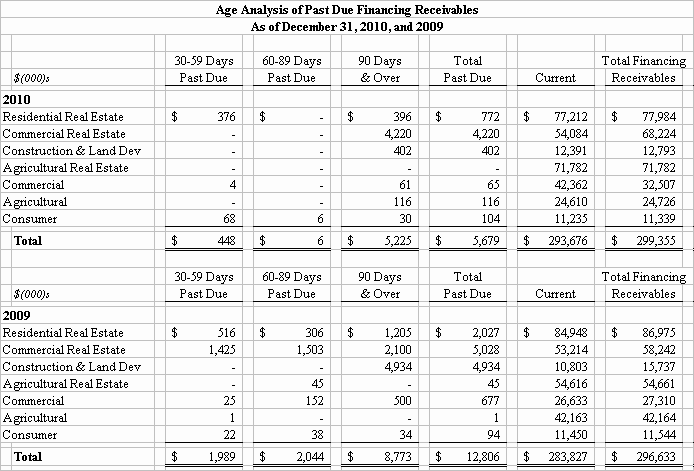
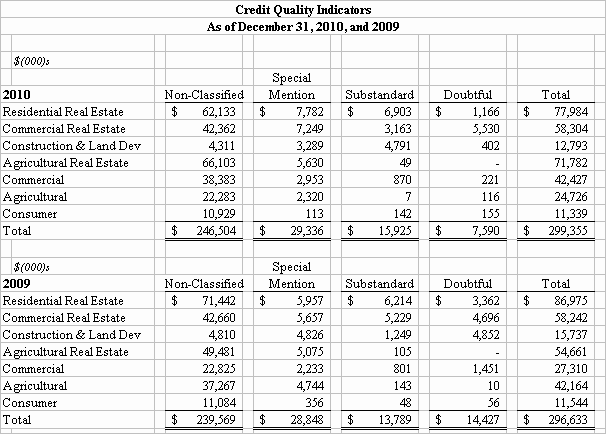
21
NOTES TO CONSOLIDATED FINANCIAL STATEMENTS
The following table shows the investment in impaired loans and the corresponding allowance for those loans along with the reduction in interest income associated with impaired loans.

22
NOTES TO CONSOLIDATED FINANCIAL STATEMENTS

23
NOTES TO CONSOLIDATED FINANCIAL STATEMENTS


24
NOTES TO CONSOLIDATED FINANCIAL STATEMENTS
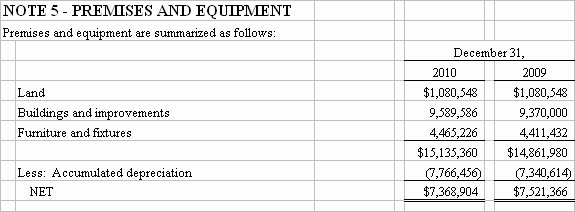
Depreciation expense was $461,817, $573,177 and $682,458 for 2010, 2009 and 2008, respectively.
NOTE 6 - INTANGIBLE ASSETS
Intangible assets consist of a core deposit intangible related to a branch acquisition. The gross carrying amount, accumulated amortization and net book value of intangibles were as follows:
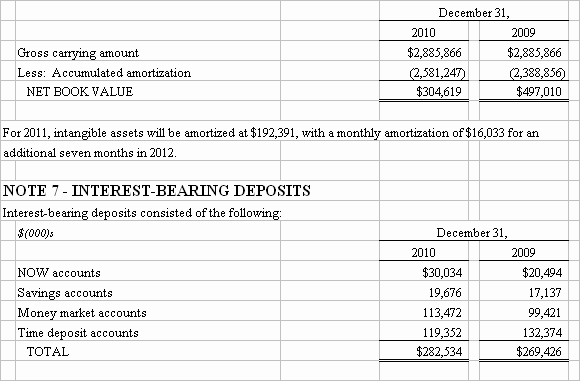

25
NOTES TO CONSOLIDATED FINANCIAL STATEMENTS
NOTE 8 - SHORT-TERM BORROWINGS
Short-term borrowings included notes payable of $13,888,046 and $17,970,928 at December 31, 2010 and 2009, respectively. DBI had an advance of $1 million drawn against its $6 million line of credit. The remaining notes payable are secured by Denmark State Bank and Denmark Ag Credit Corporation stock and agricultural loans with a carrying value of $22,009,697 and $23,990,780 as of December 31, 2010 and 2009, respectively. The pledged notes also secure long-term debt. Notes payable have fixed and variable interest rates ranging from 0.57% to 5.00% at December 31, 2010.

The notes payable to Federal Home Loan Bank of Chicago ("FHLB") are secured by residential mortgages with a carrying amount of $49.5 million and $62.1million as of December 31, 2010 and 2009, respectively, along with $3.6 million of FHLB stock at each of those dates. AgriBank, FCB notes payable are secured by agricultural loans with a carrying value of $22,009,697 and $23,990,780 as of December 31, 2010 and 2009, respectively. The pledged notes also secure short-term borrowings.
As of December 31, 2010, DBI had a total of $61,898,955 of unused lines of credit with banks to be drawn upon as needed.
26
NOTES TO CONSOLIDATED FINANCIAL STATEMENTS
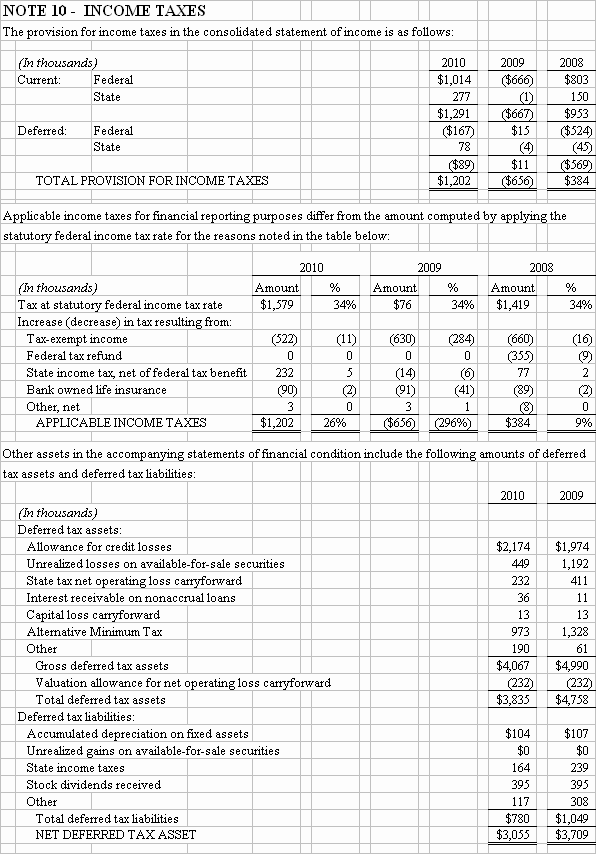
DBI has state net operating loss carryforwards of approximately $2,923,000. Portions of DBI's net operating losses have been expiring since 2000. DBI has an AMT credit carryforward of approximately $973,078.
27
NOTES TO CONSOLIDATED FINANCIAL STATEMENTS
NOTE 11 - EMPLOYEE BENEFIT PLAN
DBI has a 401(k) profit sharing and retirement savings plan. The plan essentially covers all employees who have been employed over one-half year, and are at least twenty and one-half years old. Provisions of the 401(k) profit sharing plan provide for the following:
- DBI will contribute 50% of each employee elective contribution up to a maximum DBI contribution of 2%. Employee contributions above 4% do not receive any matching contribution.
- DBI may elect to make contributions out of profits. These profit sharing contributions are allocated to the eligible participants based on their salary as a percentage of total participating salaries. The contribution percentage was 4% for 2010 and 2009 and 8% for 2008.
DBI provides no post retirement benefits to employees except for the 401(k) profit sharing and retirement savings plan discussed above, which are currently funded. DBI expensed contributions of $253,814, $274,570 and $429,644 for the years 2010, 2009 and 2008, respectively.
NOTE 12 - COMMITMENTS AND CREDIT RISK
DBI and its subsidiaries are parties to financial instruments with off-balance-sheet risk in the normal course of business to meet the financing needs of their customers. These financial instruments include commitments to extend credit and standby letters of credit. Those instruments involve, to varying degrees, elements of credit and interest rate risk in excess of the amount recognized in the statement of financial position. The contract or notional amounts of those instruments reflect the extent of involvement DBI and its subsidiaries have in particular classes of financial instruments.

The exposure of DBI and its subsidiaries to credit loss in the event of nonperformance by the other party to the financial instrument for commitments to extend credit and standby letters of credit is represented by the contractual or notional amount of these instruments. DBI and its subsidiaries use the same credit policies in making commitments and conditional obligations as for on-balance sheet instruments. DBI and its subsidiaries require collateral or other security to support financial instruments with credit risk.
Commitments to extend credit are agreements to lend to a customer as long as there is no violation of any condition established in the contract. Commitments generally have fixed expiration dates or other termination clauses and may require payment of a fee. Since many of the commitments are expected to expire without being drawn upon, the total commitment amounts do not necessarily represent future cash requirements. DBI and its subsidiaries evaluate each customer's creditworthiness on a case-by-case basis. Collateral held varies but may include accounts receivable, inventory, property, plant and equipment and income-producing commercial properties. As of December 31, 2010, variable rate commitments totaled $20,849,584.
Standby letters of credit are conditional commitments issued by DSB to guarantee the performance of a customer to a third party. Those guarantees are primarily issued to support commercial business transactions. When a customer fails to perform according to the terms of the agreement, DSB honors drafts drawn by the third party in amounts up to the contract amount. A majority of the letters of credit expire within one year. The credit risk involved in issuing letters of credit is essentially the same as that involved in extending loans to customers. Collateral held varies but may include accounts receivable, inventory, property, plant and equipment and income-producing commercial properties and residential properties. All letters of credit are secured.
28
NOTES TO CONSOLIDATED FINANCIAL STATEMENTS
NOTE 13 - RELATED PARTY TRANSACTIONS
At December 31, 2010 and 2009 certain DBI subsidiary executive officers, directors and companies in which they have a ten percent or more beneficial interest, were indebted to DBI and its subsidiaries in the amounts shown below. All such loans were made in the ordinary course of business and at rates and terms similar to those granted other borrowers.

Deposit balances with DBI's executive officers, directors and affiliated companies in which they are principal owners were $3,044,676 and $2,713,727 at December 31, 2010 and 2009, respectively.
NOTE 14 - PARENT COMPANY ONLY INFORMATION
Following, in a condensed form, are parent company only statements of financial condition, statements of income and cash flows of Denmark Bancshares, Inc. The financial information contained in this footnote is to be read in association with the preceding accompanying notes to the consolidated financial statements.
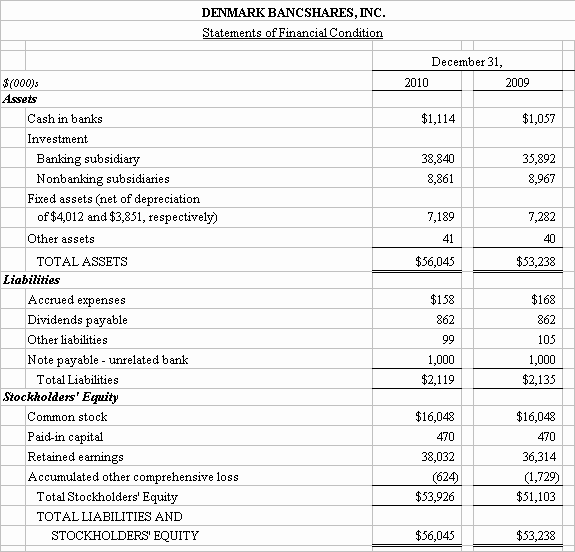
29
NOTES TO CONSOLIDATED FINANCIAL STATEMENTS

30
NOTES TO CONSOLIDATED FINANCIAL STATEMENTS
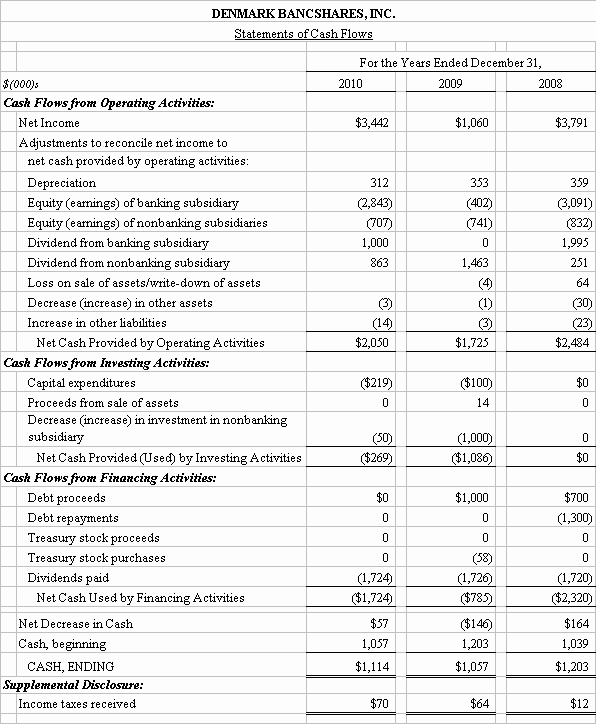
NOTE 15 - EMPLOYEE STOCK PURCHASE PLAN
In December of 1998, DBI adopted an Employee Stock Purchase Plan. All DBI employees, except executive officers and members of the board of directors, are afforded the right to purchase a maximum number of shares set from time to time by the board of directors. Rights granted must be exercised during a one-month purchase period prescribed by the board. Rights are exercised at fair market value. There were no rights granted during 2010 and 2009.
31
NOTES TO CONSOLIDATED FINANCIAL STATEMENTS
NOTE 16 - FAIR VALUE MEASUREMENTS
Fair value is the exchange price that would be received for an asset or paid to transfer a liability in the principal or most advantageous market for the asset or liability in a transaction between market participants on the measurement date. Some assets and liabilities are measured on a recurring basis while others are measured on a non-recurring basis, as required by U.S. GAAP which also establishes a fair value hierarchy which requires an entity to maximize the use of observable inputs and minimize the use of unobservable inputs when measuring fair value. Fair value estimates are made at a specific point in time based on relevant market information and information about the financial instrument. The three levels of inputs defined in the standard that may be used to measure fair value are as follows:
Level 1: Quoted prices for identical assets or liabilities in active markets that the entity has the ability to access as of the measurement date.
Level 2: Significant other observable inputs other than Level 1 prices, such as quoted prices for similar assets or liabilities, quoted prices in markets that are not active, and other inputs that are observable or can be corroborated by observable market data.
Level 3: Significant unobservable inputs that are supported by little, if any, market activity. These unobservable inputs reflect estimates that market participants would use in pricing the asset or liability.
DBI used the following methods and significant assumptions to estimate fair value.
Cash, Cash Equivalents and Federal Funds Sold: For cash, cash equivalents and federal funds sold, the carrying amount is a reasonable estimate of fair value.
Investment Securities: Investment securities available-for-sale are recorded at fair value on a recurring basis. The fair value measurement of most of DBI's available-for-sale securities is currently determined by an independent provider using Level 2 inputs. The measurement is based upon quoted prices for similar assets, if available. If quoted prices are not available, fair values are measured using matrix pricing models, or other model based valuation techniques requiring observable inputs other than quoted prices such as yield curves, prepayment speed and default rates. Three of DBI's available-for-sale mortgage-backed securities (MBS) that are secured by non-traditional mortgage loans and one available-for-sale MBS secured by traditional mortgage loans that was downgraded during the second quarter were analyzed by a third party in order to determine an estimated fair value. The estimated fair values were based on discounted cash flow analyses and are considered Level 3 inputs.
Refer to Note 3 - Investment Securities for additional detail on the assumptions used in determining the estimated fair values and additional disclosures regarding DBI's investment securities. For other securities held as investments, fair value equals quoted market price, if available. If a quoted market price is not available, fair value is estimated using quoted market prices for similar securities.
Loans Receivable: The fair value of loans is estimated by discounting the future cash flows using the current rates at which similar loans would be made to borrowers with similar credit ratings and for the same remaining maturities.
Loans Held for Sale: Mortgage loans held for sale are recorded at the lower of cost or market value. The fair value is based on a market commitment for the sale of the loan in the secondary market. These loans are typically sold within one week of funding. DBI classifies mortgage loans held for sale as nonrecurring Level 2 assets. As of December 31, 2010, loans held for sale totaled $3,715,671.
Impaired Loans: As defined below in the Glossary of Loan Terms section, a loan is considered to be impaired when, based on current information or events, it is probable that not all amounts due will be collected according to the contractual terms of the loan agreement. Impairment is measured based on the fair value of the underlying collateral. The collateral value is determined based on appraisals and other market valuations for similar assets. Under FASB ASC Topic 820, "Fair Value Measurement and Disclosures," the fair value of impaired loans is reported before selling costs of the related collateral, while FASB ASC Topic 310, "Receivables," requires that impaired loans be reported on the balance sheet net of estimated selling costs. Therefore, significant estimated selling costs would result in the reported fair value of impaired loans being greater than the measurement value of impaired loans as maintained on the balance sheet. In most instances, selling costs were estimated for real estate-secured collateral and included broker commissions, legal and title transfer fees and closing costs. Impaired loans are classified as nonrecurring Level 2 assets.
Other Investments: For other investments, the carrying amount is a reasonable estimate of fair value.
Bank Owned Life Insurance: The carrying amount of bank owned life insurance approximates fair value.
32
NOTES TO CONSOLIDATED FINANCIAL STATEMENTS
Other Real Estate Owned:
Real estate that DBI has taken control of in partial or full satisfaction of debt is currently valued at fair value. The fair value is determined by analyzing the collateral value of the real estate using appraisals and other market valuations for similar assets less any estimated selling costs. The value carried on the balance sheet of other real estate owned is the estimated fair value of the properties. Other real estate owned is classified as nonrecurring Level 2 assets.Deposit Liabilities:
The fair value of demand deposits, savings accounts and certain money market deposits is the amount payable on demand at the reporting date. The fair value of fixed-maturity certificates of deposit is estimated using the rates currently offered for deposits of similar remaining maturities as well as discounted future cash flows.Borrowings:
Rates currently available to DSB for debt with similar terms and remaining maturities are used to estimate fair value of existing debt.Commitments to Extend Credit, Standby Letters of Credit and Financial Guarantees Written:
The fair value of commitments is estimated using the fees currently charged to enter into similar agreements, taking into account the remaining terms of the agreements and the present creditworthiness of the counterparties. For fixed-rate loan commitments, fair value also considers the difference between current levels of interest rates and the committed rates. The fair value of guarantees and letters of credit is not material.Assets Recorded at Fair Value on a Recurring Basis
Assets measured at fair value on a recurring basis, are summarized in the table below:
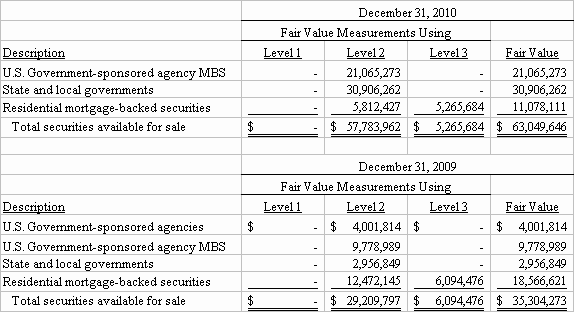
The table below presents a reconciliation and income statement classification of gains and losses for all assets measured on a recurring basis using significant unobservable inputs (Level 3) for the year-ended December 31, 2010.

33
NOTES TO CONSOLIDATED FINANCIAL STATEMENTS
Assets Recorded at Fair Value on a Nonrecurring Basis
Assets measured at fair value on a nonrecurring basis, are summarized in the following table:


34
NOTES TO CONSOLIDATED FINANCIAL STATEMENTS
NOTE 17 - REGULATORY MATTERS
DBI and DSB are subject to various regulatory capital requirements administered by the federal and state banking agencies. Failure to meet minimum capital requirements can initiate certain mandatory and possible additional discretionary actions by regulators that, if undertaken, could have a direct material effect on DBI's financial statements. Under capital adequacy guidelines and the regulatory framework for prompt corrective action, DBI must meet specific capital guidelines that involve quantitative measures of DBI's assets, liabilities and certain off-balance-sheet items as calculated under regulatory accounting practices. DBI's capital amounts and classification are also subject to qualitative judgments by the regulators about components, risk weightings and other factors.
Quantitative measures established by regulation to ensure capital adequacy require DBI and DSB to maintain minimum amounts and ratios (set forth in the table below) of Total Capital and Tier 1 Capital (as defined in the regulations) to risk-weighted assets (as defined) and of Tier 1 Capital (as defined) to average assets (as defined). Management believes, as of December 31, 2010, that DBI and DSB meet all capital adequacy requirements to which they are subject.
As of December 31, 2010, the most recent notification from the Federal Deposit Insurance Corporation categorized DSB as well-capitalized under the regulatory framework for prompt corrective action. To be categorized as well-capitalized DSB must maintain minimum total risk-based, Tier 1 risk-based and Tier 1 leverage ratios as set forth in the table.
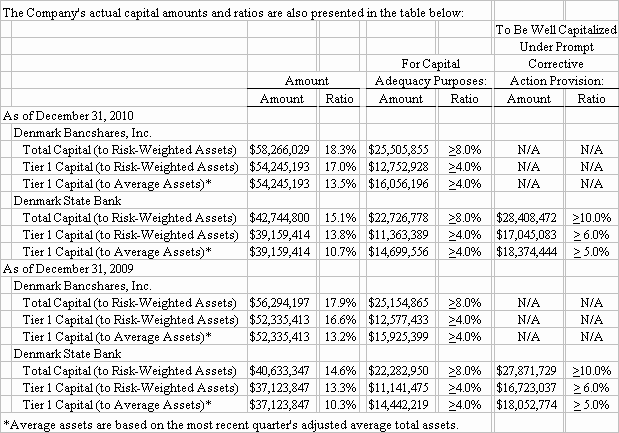
Wisconsin law provides that state chartered banks may declare and pay dividends out of undivided profits but only after provision has been made for all expenses, losses, required reserves, taxes and interest accrued or due from the bank. Payment of dividends in some circumstances may require the written consent of the Division.
35
MANAGEMENT'S DISCUSSION AND ANALYSIS
Background
Management's discussion and analysis of financial condition and results of operations of Denmark Bancshares, Inc. and its subsidiaries ("DBI"), is intended as a review of significant factors affecting DBI's consolidated results of operations during the three-year period ended December 31, 2010, and DBI's consolidated financial condition at the end of each year of the two-year period ended December 31, 2010. This discussion should be read in conjunction with the "CONSOLIDATED FINANCIAL STATEMENTS" including the accompanying notes, and the "SELECTED FINANCIAL DATA" presented elsewhere in this report. DBI's subsidiaries are the Denmark State Bank ("DSB"), Denmark Agricultural Credit Corporation ("DACC"), and DBI Properties, Inc. ("Properties"). Properties was formed in February 2009 for the purpose of holding certain foreclosed properties.
This report may contain certain forward-looking statements, including without limitation, statements regarding results of operations, the adequacy of the allowance for loan and lease losses, the amounts of charge-offs and recoveries, capital to assets ratios, capacity for paying dividends and liquidity. These forward-looking statements are inherently uncertain and actual results may differ from Management's expectations, The following factors, which, among others, could impact current and future performance include but are not limited to: (i) adverse changes in asset quality and resulting credit risk-related losses and expenses; (ii) adverse changes in the local economy; (iii) fluctuations in market rates and prices which can negatively affect net interest margin, asset valuations and expense expectations; and (iv) changes in regulatory requirements of federal and state agencies applicable to banks and bank holding companies, which could have materially adverse effects on DBI's future operating results. When relying on forward-looking statements to make decisions with respect to DBI, investors and others are cautioned to consider these and other risks and uncertainties including the risks described under the caption "Risk Factors" in our Annual Report on Form 10-K for the year-ended December 31, 2010. All forward-looking statements contained in this report are based upon information presently available and DBI assumes no obligation to update any forward-looking statements.
Critical Accounting Policies
The accounting and reporting policies of DBI are in accordance with accounting principles generally accepted in the United States of America and conform to general practices in the banking industry. The preparation of financial statements in conformity with these principles requires management to make estimates and assumptions that affect the reported amounts of assets and liabilities at the date of the financial statements, and the reported amounts of revenues and expenses during the reporting period. These estimates and assumptions are based on information available at the date of the financial statements. Certain policies inherently have a greater reliance on the use of estimates, assumptions, and judgments and as such have a greater possibility of producing results that could be materially different than originally reported. Management believes that DBI's critical accounting policies are those relating to the allowance for loan and lease losses, the valuation of investment securities and intangible assets.
Allowance for Loan and Lease Losses
The allowance for loan and lease losses ("ALLL") is an estimate of the losses that may be sustained in the loan and lease portfolio. Please refer to the Allowance for Loan Losses section of Note 1 - Summary of Significant Accounting Policies above for detail on the allowance methodology. Management believes that the ALLL is appropriate as of December 31, 2010.
Valuation of Investment Securities
Investment securities are classified as available for sale and are valued at their fair market value. Please refer to the Investment Securities section of Note 1 - Summary of Significant Accounting Policies, Note 3 - Investment Securities and Note 16 - Fair Value Measurements for additional details on the valuation of investment securities.
Intangible Assets
DBI has a core deposit intangible asset that was originated in connection with DSB's expansion through an acquisition of an established branch operation in 1997. The acquisition did not meet the definition of a business combination in accordance with ASC 805 - Accounting for Business Combinations Occurring in Periods Beginning before December 15, 2008. As such, DBI continues to amortize the intangible asset related to the acquisition over a period of fifteen years. Annually DBI reviews the intangible assets for impairment and records an impairment charge, if any, to earnings.
Glossary of Loan Terms
Impaired Loan - A loan is impaired when, based on current information and events, it is probable that not all amounts due will be collected according to the contractual terms of the loan agreement. Impaired loans are measured at the estimated fair value of the collateral. If the estimated fair value of the impaired loan is less than the recorded investment in the loan, an impairment is recognized by creating a valuation allowance.
Nonaccrual Loan - DSB's policy is to place in nonaccrual status all loans which are contractually past due 90 days or more as to any payment of principal or interest and all other loans as to which reasonable doubt exists as to the full, timely collection of interest or principal based on management's view of the financial condition of the borrower. When a loan is placed on nonaccrual, all interest previously accrued but not collected is reversed against current period interest income. Income on such loans is then recognized only to the extent that cash is received and where the future collection of principal is probable. Interest accruals are resumed on such loans only when they are brought fully current with respect to interest and principal and when, in the judgment of management, the loans are estimated to be fully collectible as to both principal and interest.
36
MANAGEMENT'S DISCUSSION AND ANALYSIS
Non-Performing Assets - Non-performing assets include nonaccrual loans as defined above and real and personal properties acquired in satisfaction of debts previously owed.
Past Due Accruing Loans - A loan on which all or part of a scheduled payment is delinquent by more than 30 days but less than 90 days past due, except loans that are considered nonaccrual.
Potential Problem Loans - Potential problem loans are accruing loans in which there exists doubt as to the ability of the borrower to comply with present loan repayment terms. Management's decision to place loans in this category does not necessarily mean that DBI expects losses to occur on these loans, but that management recognizes that a higher degree of risk is associated with these accruing loans and they deserve closer scrutiny.
Restructured Loans - Restructured loans involve the granting of some concession to the borrower involving the modification of terms of the loan, such as changes in the payment schedule, the amortization term, the interest rate, or a combination of these.
Risk Rating - Risk rating, which is also sometimes referred to as loan grade, is the credit quality grade assigned to each loan. Loans are assigned a risk rating upon origination. Lenders and credit review analysts conduct periodic reviews and evaluations and make adjustments to the assigned grades when appropriate. The range of categories from the best quality to worst is as follows: highest quality, solid quality, some weakness, inherent industry weakness, special mention, substandard, doubtful and loss. Impaired loans are generally assigned a substandard or doubtful risk grade.
Special Mention Loans - Loans classified "special mention" are one step above substandard loans as described below. These loans contain some weakness, which if not corrected or improved upon could lead to further deterioration and a lower rating.
Substandard - A "substandard" loan is a loan that is inadequately protected by the current net worth and paying capacity of the borrower or the value of any collateral. Loans classified "substandard" have well-defined weaknesses that jeopardize prospects for liquidation and are characterized by the distinct possibility that some loss will be sustained if the deficiencies are not corrected.
OVERVIEW
DBI recorded net income of $3,442,000, or $28.94 per share for the year ended December 31, 2010, up from $878,000 or $7.38 per share in 2009. Return on average assets and return on average equity for 2010 were 0.85% and 6.63% respectively, compared to 0.22% and 1.70%, respectively, for the same period one year ago.
DBI's profitability is largely dependent on the loan portfolio. Interest income and fees on loans totaling $16.9 million in 2010 represents 78% of gross revenues. Average loans outstanding increased by $2.0 million during 2010, and total loans outstanding at December 31, 2010 were $2.7 million higher than the previous year-end.
The increase in net income for 2010 was primarily due to a decrease of $4.3 million in the provision for loan losses. DBI's annual provision for loan losses was $1.2 million in 2010 compared to $5.5 million during 2009. The ratio of allowance for loan losses to total loans was 2.29% at December 31, 2010, compared to 2.10% at December 31, 2009. Net charge-offs for 2010 totaled $0.6 million compared to net charge-offs of $5.6 million in the prior year. DBI's ratio of loans over 30 days past due (including nonaccrual loans) to total loans was 3.0% as of December 31, 2010, compared to 5.5% as of year-end 2009. Loans past due less than 90 days were $0.5 million compared to $3.5 million one year earlier and nonaccrual loans fell to $8.6 million at year-end compared to $12.8 million at year-end 2009.
The special asset group (formed in 2009 and consisting of three lenders) closely monitors problem credits and initiates foreclosure proceedings, personal property asset repossessions and disposition of acquired properties. DBI disposed of eight real estate properties totaling $1.8 million and acquired eleven properties valued at $1.2 million in 2010. At year-end 2010 DBI owned eleven properties valued at $863,941. DBI recorded $583,255 of expenses associated with foreclosed properties during 2010 compared to $501,288 during 2009. These expenses are onerous and do not include the additional costs of management salaries and benefits for workout specialists. Expenses associated with acquired properties will remain elevated until the nonperforming assets decline significantly. DBI had about a dozen foreclosure proceedings in process at year-end and will continue to aggressively collect nonperforming loans and dispose of acquired properties.
DBI's loan portfolio contains $221 million or 74% of total loans secured by real estate. The decline in residential and commercial real estate values throughout our market area has caused some loans to be under collateralized. DBI also has a niche in agricultural lending in its market area. The agricultural loan portfolio (including loans secured by farmland) was $97 million at year-end 2010 and represents 32% of total loans. The agricultural economy experiences cyclical fluctuations and is discussed below. DBI experienced net recoveries during the last five years on the agricultural portfolio and a low level of past due loans. The commercial real estate portfolio was $58 million or 20% of total loans at year-end 2010. The construction and land development portfolio has declined 56% from a high of $29.2 million in 2005 to $12.8 million at year-end 2010. While the collapse of the housing market led to the economic downturn, commercial real estate became the next problem area and remains at depressed levels. Nonaccrual commercial real estate loans totaled $5.7 million and represent 66% of DBI's total nonaccrual loans and 1.9% of total loans at December 31, 2010
.
37
MANAGEMENT'S DISCUSSION AND ANALYSIS
DBI also experienced asset quality issues in the investment portfolio and recognized OTTI credit losses totaling $119,772 during 2010 compared to $312,716 in 2009. The OTTI credit losses relate to two non-agency residential mortgage-backed securities with loans concentrated in California, which experienced severe housing price declines. These securities were rated AAA when purchased but are backed by option adjustable rate mortgages (ARMs), including some with negative amortization features. DBI continues to closely monitor the non-agency mortgage backed securities portfolio and additional credit losses are possible.
Net interest income for 2010 was $14.5 million compared to $14.6 million during 2009. Noninterest income increased from $1.9 million in 2009 to $2.1 million during 2010, while noninterest expense declined from $10.8 million in 2009 to $10.7 million for the current year. The increase in noninterest income was primarily attributable to an increase of $86,000 in retail investment sales and $46,000 of rental income received on leased space at the Wrightstown branch. DBI measures how efficiently it is generating net income by comparing its spending on noninterest overhead expenses to its operating income (the resulting computation is called the efficiency ratio). A lower ratio indicates better efficiency. The efficiency ratio was 61% for 2010, compared to 60% and 64% for the years ended 2009 and 2008, respectively. The 2010, 2009 and 2008 efficiency ratios, calculated without the nonrecurring expenses of $583,255, $501,288 and $915,940, respectively, associated with foreclosed properties were 58%, 57% and 59% respectively. The significant items of noninterest expense are discussed on the following pages.
As of December 31, 2010, DBI's leverage capital ratio (tier 1 capital to average assets) of 13.5% and total capital as percentage of risk-based assets ratio at 18.3% compared to 13.2% and 17.9%, respectively, as of December 31, 2009. DBI declared dividends totaling $14.50 per share which represented a dividend payout of 50% of earnings per share of $28.94 in 2010. DBI continues to maintain a strong capital position in relation to its peers, which positions DBI for potential growth in total assets. DBI's leverage ratio is over 70% higher than peer bank holding companies leverage ratio of 7.8%. DBI's peer group average total capital as a percent of risk-based assets was 12.6%. The peer group data was obtained from the latest available holding company data as of September 30, 2010, from the Federal Reserve's Bank Holding Company Performance Report, and consists of 103 bank holding companies with total assets of less than $500 million.
DBI maintains liquid assets and established lines of credit to meet its liquidity needs. DBI has a Contingency Funding Plan that, among other things, identifies liquidity risks, requires periodic reporting to the Board of Directors and defines a liquidity crisis. The plan reviews the asset and liability based sources and uses of liquidity for DBI, DSB and DACC. DSB relies on a stable mix of funding sources and only had $250,000 in brokered deposits as of year-end 2010. DSB's net noncore fund dependence as of December 31, 2010, was 11%. This compares favorably to the peer group average of 25% obtained form the Uniform Bank Performance Report of banks with total assets between $250 million and $1 billion as of year-end 2010. Management believes DBI's liquidity position is adequate under current economic conditions.
Local Economy Rebounding Slowly
The local economic conditions prevailing at year-end 2010 varied by county, but each county experienced lower unemployment than one year earlier. The areas' unemployment rates in December 2010 were lower than the national unemployment rate of 9.4%. Local county unemployment rates ranged from a low of 6.3% in Brown County to a high of 7.7% in Manitowoc County, compared to 7.4% and 9.5%, respectively, one year ago. Brown County home sales fell 13% from 2,369 in 2009 to 2,078 units in 2010. The median price of a home in Brown County increased $139,000 from $135,000 and $147,100 during 2009 and 2008, respectively.
The agricultural economy rebounded in 2010, one year after experiencing one of its toughest years since the early 1970s. Milk prices increased 23% in 2010 and averaged $16 per hundredweight compared to $13 per hundredweight in 2009. 2010 prices were still well below the $19 milk prices experienced in 2007 and 2008. The higher milk prices and lower feed costs allowed Wisconsin farmers' net income in 2010 to rise to an estimated $1.5 billion, or 87% higher than the $800 million reported during 2009.
The U.S. economy recovered in 2010 with real GDP growth of 2.5%, but the unemployment rate remained near 10% for most of the year. U.S. housing starts for the first three quarters of 2010 were less than 30% of the peek in 2005. Federal tax credits helped home sales in late 2009 and early 2010, but home sales fell after the tax credits expired in April 2010. U.S. inflation remained relatively low. The challenges in 2011 will include high residual unemployment, weak consumer spending, concern about national debt levels and political uncertainty about increased taxes, lower federal spending, increased regulation on businesses and events occurring in the Middle East, which could result in a spike in oil prices.
Interest rates remained low in 2010 due to the continued stressed economic conditions. The Federal Reserve kept the federal funds rate (inter-bank lending rate) at 0% - 0.25% throughout all of 2009 and 2010 and the prime rate of interest set by banks remained at 3.25%. Since the Fed is unable to stimulate the economy by lowering short-term interest rates from the current level, the Federal Open Market Committee announced a second round of quantitative easing in November 2010. The Fed will purchase $75 billion of Treasury securities each month for eight months. The Fed previously bought about $1.7 trillion from December 2008 to March 2010. The Fed continues to seek a dual mandate of price stability with an acceptable range of inflation of 1.5 to 2 percent and maximum employment.
38
MANAGEMENT'S DISCUSSION AND ANALYSIS
Banking Industry Continues to Struggle
It continues to be a challenging period for many banks nationwide as 157 more FDIC insured banks failed in 2010 compared to 140 bank failures in 2009 and 25 in 2008. This represented the most bank failures since 1992 when 179 banks failed. The number of 2011 bank failures is likely to remain high as twenty two banks have already failed as of February 18, 2011 and the FDIC's list of "problem banks" exceeds 850 banks. The Dodd-Frank Wall Street Reform Act requires the FDIC to increase the Deposit Insurance Fund to 1.35% of insured deposits by September 2020. The FDIC announced that it will forego the uniform 3 basis point increase in assessment rates that was scheduled to take effect on January 1, 2011. Current rates will remain in effect until the reserve ratio reaches 1.15 percent, which is expected to occur in 2018. The amount of DBI's FDIC insurance premiums have increased to more than twelve times the levels in 2005, when premiums totaled $50,965 compared to $649,058 during 2010.
While considerable improvement was made by DBI in improving asset quality and profitability during 2010, significant challenges remain for 2011. Management has identified the following challenges:
- Continuing the improvement of the credit quality of the loan portfolio by proactively monitoring the performing portfolio, aggressively collecting the nonperforming loans, selling the foreclosed properties, reducing expenses related to foreclosed properties and adding new higher quality loans.
- Complying with the new regulations mandated by the Consumer Protection Act and dealing with a new regulator (Bureau of Consumer Financial Protection) created by the Dodd-Frank Wall Street Reform Act.
- Managing interest rate risk in the current environment of historically low interest rates with the expectation that rates will increase rapidly when the Fed reverses the current monetary policy. DBI's Asset Liability Committee is closely monitoring market interest rates and will adjust loan and deposit rates and terms accordingly. DBI has limited most recent investment purchase maturities to 5 years or less.
- Closely monitoring the agricultural real estate portfolio and lending conservatively as farmland values are almost 60% higher than their levels in 2000. As corn and soybean prices have increased so has the value of farmland. The last major decline in farmland prices occurred in the early 1980s.
- Growing the loan portfolio with quality credits in this still sluggish economy. Quality loan growth will be required in order to increase net interest income and overall profitability.
- Successfully integrating variable compensation plans to the retail and business banking sales staff to properly incent growth of retail and business relationships.
- Maintaining mortgage banking revenues at the levels experienced during the last two years while experiencing continued sluggishness in the housing market and without the benefit of federal tax incentives.
- Potential losses of revenues on debit card interchange fees as a result of the Durbin Amendment to the Wall Street Reform Act.
DBI highlights from 2010 include the following:
- Successfully transitioned to a new DSB President as Jill S. Feiler succeeded Jack Olsen on January 1, 2010.
- Maintained a consistent dividend payout declaring the 54th consecutive semi-annual dividend since formation as a holding company in 1983.
- Achieved significant improvement in asset quality, lowering nonperforming assets from $14.4 million to $9.5 million and net charge-offs by more than $5 million from $5.6 million to $0.6 million.
- Increased net interest spread to 3.85%, which was the highest recorded since 2004 and 87 basis points higher than the 2.98% spread during 2006.
- Reduced occupancy expense to just over $1 million, the lowest since 2003 and 32% lower than the all-time high of $1.5 million in 2005.
- Entered into a long-term lease with a third party for two thirds of the total office space at our Wrightstown branch location.
- Implemented a new, more user-friendly and interactive web site that now offers online account opening and online loan applications.
- Hired Kristine Hernandez, Assistant Vice President, to lead the retail and business banking sales efforts. Kristine has an extensive background in banking, sales and commercial real estate.
39
MANAGEMENT'S DISCUSSION AND ANALYSIS
RESULTS OF OPERATIONS
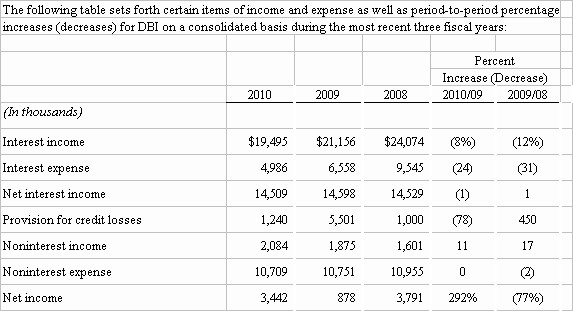
Earnings Performance Summary
DBI recorded net income of $3,441,686 in 2010. This represents an increase of $2,563,363 or 292% compared to 2009 earnings. The increase in net income is primarily attributable to a decrease in the provision for loan losses of $4.3 million, as well as an increase in non-interest income of $208,744. Total interest income decreased by $1,660,601 or 8% lower than 2009, while total interest expense fell by $1,571,536 or 24% from 2009. This resulted in a decrease of $89,065 in net interest income for the year ended December 31, 2010, compared to one year earlier.
Net income during 2009 decreased $2,912,910 or 77% compared to 2008 earnings. The decrease in net income was primarily attributable to an increase in the provision for loan losses of $4.5 million, as well as a write-down of $312,716 on available-for-sale securities determined to be other-than-temporarily impaired. Total interest income decreased by $2,918,565 or 12% from 2008, while total interest expense fell by $2,987,882 or 31% from 2008. This resulted in the increase of $69,317 in net interest income for the year ended December 31, 2009, compared to one year earlier.
On a per share basis, net income was $28.94 in 2010 compared to $7.38 in 2009 and $31.84 in 2008. Return on average assets for DBI was 0.85% in 2010 compared to 0.22% in 2009 and 0.96% in 2008. Return on average equity in 2010 was 6.7% compared to 1.7% and 7.2% in 2009 and 2008, respectively.
Income Taxes
DBI recorded a combined federal and state income tax provision of $1,202,380 during 2010, a tax benefit of $656,174 in 2009 and a provision of $383,982 in 2008. These reflect effective income tax rates of 26%, (295%) and 9% in 2010, 2009 and 2008, respectively, which are less than DBI's combined statutory tax rate of 39%. The lower effective income tax rates are primarily attributable to non-taxable interest income earned on state and local government investment securities in relation to pre-tax income. DBI's 2008 provision for income taxes was reduced by $355,289 from a tax refund.
40
MANAGEMENT'S DISCUSSION AND ANALYSIS
DBI's consolidated average statements of financial condition, interest earned and interest paid, and the average interest rates earned and paid for each of the last three years are:

- Nonaccrual loans are included in the average daily balance figure, but interest income associated with these loans is recognized under the cash basis method of accounting.
- The yield on tax-exempt loans and securities is computed on a tax-equivalent basis using a tax rate of 34%.
- Securities are shown at amortized cost.
41
MANAGEMENT'S DISCUSSION AND ANALYSIS
Net Interest Income
The following table sets forth a summary of the changes in interest earned and interest paid resulting from changes in volume and changes in rates. Changes that are not due solely to volume or rate have been allocated to rate.

Net interest income is the largest component of DBI's operating income. Net interest income represents the difference between interest income on earning assets, such as loans and securities, and the interest expense on deposits and other borrowed funds. Net interest income is affected by fluctuations in interest rates and by changes in the volume of earning assets and interest-bearing liabilities outstanding. Net interest income in the following discussion has been adjusted to a taxable equivalent level (tax-exempt interest has been increased to a level that would yield the same after-tax income had that income been subject to tax at a 34% tax rate) and therefore differs from the amount reported in the Consolidated Statements of Income.
Net interest income on a taxable equivalent basis decreased $249,229 or 2% between 2010 and 2009. The decline is the result of an increase in the average balance of interest-bearing liabilities of $3.4 million and a decrease in the average balance of interest-earning assets of $2.6 million. Despite the decline in net interest income, the net interest spread increased 7 basis points. Net interest spread is the difference between the average yield earned on assets and the average rate incurred on liabilities. The increase is mostly attributable to a lower overall cost of funds, which declined 52 basis points from 2.09% in 2009 to 1.57% in 2010. This improvement was primarily due to a decline in certificate of deposit rates of 75 basis points from prior year. This was partially offset by a decline in the yield earned on assets which fell 45 basis points. The tax-equivalent net interest spread was 3.85% during 2010, compared to 3.78% and 3.64% during 2009 and 2008, respectively.
Net interest income on a taxable equivalent basis remained fairly stable, with a slight increase being recognized between 2009 and 2008. The increase was the result of an improvement in the net interest spread of 14 basis points over the prior year. The increase was mostly attributable to a lower overall cost of funds which declined 99 basis points from 3.08% in 2008 to 2.09% in 2009. This improvement was primarily due to a decline in money market rates of 116 basis points along with the decline in the cost of certificates of deposit of 113 basis points from prior year. This more than offset the decrease in the yield earned on assets which declined 85 basis points.
42
MANAGEMENT'S DISCUSSION AND ANALYSIS
Noninterest Income

Noninterest income in 2010 was $2,083,986, an increase of $208,744 or 11% over 2009. The increase is due to improvements in several areas. Rental income on other real estate properties increased $76,534 or 77% in 2010 over income posted in 2009 due to rents received on the property held by DBI's real estate subsidiary during most of 2010. Rental income received on the lease of excess office space at the Wrightstown branch resulted in an increase of $45,896 or 414% for the year-ended December 31, 2010 compared to one year earlier. ATM and VISA surcharge income is 20% higher, totaling $261,320 in 2010 compared to $217,359 in 2009. Investment security gains of $68,156 were recognized during 2010, an increase of 79% over the gains in 2009. The securities sales were executed in an effort to increase the credit quality of DBI's investment portfolio.
Noninterest income in 2009 totaled $1,875,242, an increase of $274,139 or 17% over 2008. The increase was primarily the result of loan sales gains of $285,494 recognized during 2009. DSB sold $26.1 million of residential real estate loans to the secondary mortgage market during 2009 compared to $5.9 million in 2008. As a result, gains on the sale of the loans increased $220,555 or 338% over gains recorded in 2008. In addition, service fees and commissions increased $61,037 or 7% to $894,581 during 2009. Service charges and overdraft fees on deposit accounts increased by $89,356, primarily due to increased overdraft charges on deposit accounts and higher service charges on business checking accounts as a result of lower earnings credits. Commissions recorded from the sales of mutual funds, annuities, common stocks and insurance decreased by $35,011. Investment security gains of $38,444 were realized in 2009 due to a restructuring of the portfolio as compared to $31,486 in 2008.
Other-than-Temporary Impairment Losses
In April 2009, the FASB issued guidance under Topic 320, which is discussed in Note 1 to the financial statements above, to make the guidance more operational and to improve the presentation and disclosure of other-than-temporary impairments (OTTI) on debt and equity securities in the financial statements. Under Topic 320, if the determination is made that there is other-than-temporary impairment and that a credit loss exists but the entity does not intend to sell the debt security, and it is not more likely than not that the entity will be required to sell the debt security before the anticipated recovery of its remaining amortized cost basis, the presentation and amount of the OTTI recognized in the statement of earnings is changed. Only the portion related to the credit loss is recognized in the statement of earnings and the impairment related to all other factors is recognized in other comprehensive income.
Two available-for-sale securities that were analyzed for OTTI were determined to be other-than-temporarily impaired during 2009. A portion of the unrealized loss was found to be related to credit loss. As such, $312,716 was written off through the income statement in 2009. Ongoing analysis during 2010 resulted in additional credit losses of $119,772 on one of the two OTTI securities to be recognized through the income statement. Additional details on the analysis that was performed on these securities can be found in Note 3 - Investment Securities.
Noninterest Expense
Total noninterest expense was $10,589,399, an increase of $151,207 or 1% in 2010. Salaries and employee benefits increased 3% or $183,148 during 2010 over expenses recorded in 2009. Net losses recorded on the sales or write-downs of other real estate properties acquired through foreclosure increased $96,602 in 2010 to $126,289 compared to 2009. Occupancy expenses declined by 9% or $105,985 for the year-ended December 31, 2010 from $1,128,484 recorded one year prior.
43
MANAGEMENT'S DISCUSSION AND ANALYSIS
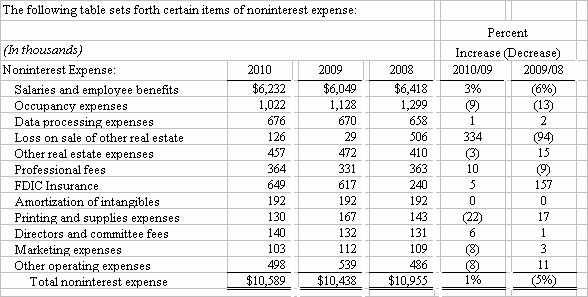
Salaries and employee benefits expense increased $183,148 or 3% in 2010. The increase is primarily attributable to an increase in salaries and wages of $418,045 or 9% due to an accrual of $360,000 during 2010 for incentives while there were no incentives accrued during 2009, as well as an increase of $75,000 in deferred compensation for plans that were established in 2010. These increased expenses were partially offset by a decline of $192,115 or 19% in health and life insurance expenses during 2010 resulting from a 50% decrease in the amount of life insurance provided to employees, the introduction of a high deductible health plan with lower premiums, the reduced number of employees covered under the plans and a provider rebate received during 2010 that was not received in 2009. The number of full-time equivalent employees declined from 94 in 2009 to 85 in 2010.
Professional fees increased $32,877 or 10% to $364,110 for the year-ending December 31, 2010 from $331,233 during 2009. Professional fees include expenditures for legal, audit, compliance, tax and other professional services. The increase was primarily attributable to legal expenses of $101,482 during 2010 compared to $34,783 in 2009. These expenses were related to items such as foreclosure and collection matters, employment-related issues and regulatory disclosures.
Occupancy expenses decreased by $105,985 or 9% in 2010 primarily as a result of lower depreciation expense, which was $111,360 lower than 2009. That downward trend will continue in 2011 as DBI has no major capital improvement plans. Printing and supplies decreased by $36,822 or 22% during 2010. This decline is primarily attributable to a $15,415 reduction in expenses related to statement printing services that were utilized during most of 2009 but not during 2010.
Total noninterest expense was $10,438,192, a decrease of $516,694 or 5% in 2009 compared to 2008. Net losses recorded on the sales or write-downs of other real estate properties acquired through foreclosure decreased $476,497 in 2009 to $29,687 compared to 2008. Expenses incurred on acquired properties totaled $471,601 in 2009, an increase of $61,845 over 2008. These expenses consisted primarily of costs for real estate taxes, repairs and maintenance, insurance and legal. This resulted in a net improvement in costs related to acquired properties of $414,652 in 2009 from the prior year.
Salaries and employee benefits expense decreased $368,986 or 6% in 2009 versus 2008. The decrease was primarily attributable to a decrease in salaries and wages of $359,382 or 7%, along with a reduction of $155,074 in DBI's contribution to employees' 401(k) plans. The discretionary portion of the 401(k) contribution was 4% in 2008. Given the financial performance during 2009, the Board of Directors voted against funding the discretionary contribution for that year. The number of full-time equivalent employees declined from 95 in 2008 to 94 in 2009. These cost savings were partially offset by an increase in health insurance related expenses of $149,673 or 18% in 2009 from $843,961 in 2008.
Occupancy expenses decreased by $170,670 or 13% in 2009 primarily as a result of lower depreciation expense, which fell by $109,281. Also contributing to the improvement in occupancy expenses was a decline of $45,459 related to equipment maintenance costs.
Professional fees decreased by $32,066 or 9% during 2009. The decrease was primarily attributable to a reduction in expenses related to accounting and auditing services of $46,237 in 2009, along with a decline in legal and recording expenses of $18,273. These improvements were partially offset by an increase in consulting fees of $38,142 due primarily to expenses of approximately $24,000 for an external audit of information technology during 2009.
44
MANAGEMENT'S DISCUSSION AND ANALYSIS
FDIC insurance premiums increased by $377,432 during 2009 compared to 2008. The significant increase was due to the premium going from 7 basis points in 2008 to 14 basis points in 2009. In addition, a special assessment was charged during 2009 to help fund the costs of bank failures that were depleting the insurance fund. DBI's quarterly premiums averaged $115,019 during 2009 as compared to $59,098 for 2008. The special assessment paid during the third quarter of 2009 was $161,185. As an alternative to an additional special assessment given the strain that bank failures had on the fund, the FDIC required banks to prepay premiums for the 4th quarter of 2009 through the 4th quarter of 2012 as of December 30, 2009. The amount of that pre-payment for DSB was $1.8 million, however the expense will be expensed during the period to which it applies.
FINANCIAL CONDITION
The following table sets forth certain assets and liabilities of DBI on a consolidated basis as of the end of each of the three most recent fiscal years and period-to-period percentage increases (decreases):
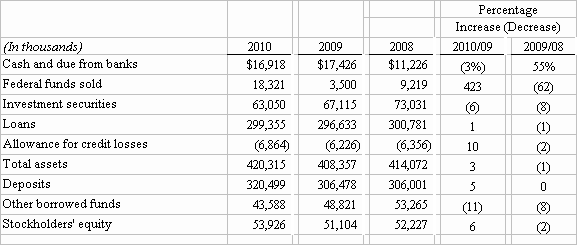
Loans
Loans secured by residential mortgages totaled $78 million or 26% of total loans, which represented DBI's largest single category of loans at the end of 2010. These loans are substantially all fixed rate loans with original terms of one, three, five and ten years. At the end of the original term the notes are renewed, subject to updated credit and collateral valuation information but generally without fees or closing costs to the customer. Virtually all of these notes amortize principal indebtedness over a fifteen to thirty-year period, and are repriceable at fixed rates that generally follow prevailing longer-term rates. DBI offers a Hometown Mortgage product to consumers and held $16.9 million of 10-year fixed rate mortgages yielding 5.43% at year-end 2010. These loans will be held in the portfolio and require amortization over 30 years and a balloon payment at the end of the 10-year term. During 2010, $555,700 of loans secured by residential properties were transferred to acquired properties and $322,612 of charge-offs were recorded on loans secured by residential properties. Also, during 2010, $26.6 million of residential mortgages were sold on the secondary market. Of those loans sold on the secondary market, $6 million was from existing DSB loans that were refinanced. Management attributes the $9.0 million decline in 2010 in residential mortgages to the refinancings, the transfers to acquired properties and the charge-offs.
At December 31, 2010, $96.5 million or 32% of DBI's outstanding loans were deemed "agriculture-related," constituting the highest industrial concentration in the portfolio. Of these loans, over 90% relate directly to the dairy farming industry. Most of these notes are written on a one-year basis, which allows DBI to review credit information and collateral values annually to ensure continued loan quality. Total agriculture-related loans were down $0.3 million from prior year end, although agricultural real estate loans were up and agriculture production loans were lower. This was partially due to an internal reclassification from production to real estate on loans secured by both as the primary collateral was identified during the annual renewal process.
Commercial loans increased by $15.1 million or 55% in 2010. Management attributes the increase in the commercial portfolio to one large loan that was originated with a 65% USDA guarantee and the purchase of a $6 million participation from a large regional commercial bank.
45
MANAGEMENT'S DISCUSSION AND ANALYSIS
The following table sets forth major types of loans (excluding loans held for sale) by primary collateral at the end of the last five years:
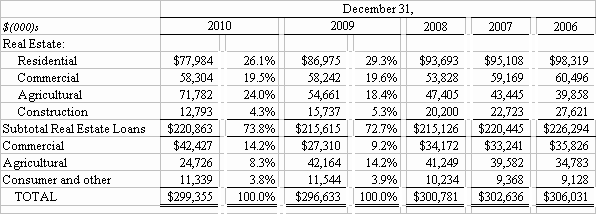
The majority of DBI's unsecured loans are comprised of credit card advances, which aggregated $527,689 or 0.17% of total loans outstanding, personal reserve overdraft protection accounts, which aggregated $257,321 or 0.09% of total loans outstanding and deposit account overdrafts totaling $69,365 at December 31, 2010.
The following table shows nonaccrual loans by primary collateral as of the end of each of the last five years:

Nonaccrual loans declined $4.1 million or 32% in 2010 from the prior year. Approximately 94% or $8.1 million of the total nonaccrual loans at December 31, 2010 are secured by real estate. Management considers these loans either adequately secured or has allocated an appropriate amount in the allowance for loan losses to cover a collateral shortfall. Commercial real estate loans that are on nonaccrual increased $2.5 million as of December 31, 2010, while construction-related nonaccrual loans declined $4.4 million or 92%. DBI has initiated legal proceedings against several of the borrowers whose loans are nonperforming as of year-end.
DBI has no accruing loans that are past due 90 days or more. DBI's policy is to place in nonaccrual status all loans which are contractually past due 90 days or more as to any payment of principal or interest and all other loans as to which reasonable doubt exists as to the full, timely collection of interest or principal based on management's view of the financial condition of the borrower. Previously accrued but uncollected interest on loans placed on nonaccrual status is charged against the current earnings, and interest income thereafter is recorded only when received.
Restructured loans at December 31, 2010, were $5,910,202 compared to $2,417,557 and $2,494,127 as of year-end 2009 and 2008, respectively. Restructured loans involve the granting of some concession to the borrower involving the modification of terms of the loan, such as changes in payment schedule or interest rate. The restructured loans at year-end involved the lengthening of the amortization period.
Potential problem loans totaled $44.1 million at December 31, 2010, compared with $43.0 million one year earlier. Potential problem loans are accruing loans in which there exists doubt as to the ability of the borrower to comply with present loan repayment terms. Management's decision to place loans in this category does not necessarily mean that DBI expects losses to occur on these loans, but that management recognizes that a higher degree of risk is associated with these accruing loans and they deserve closer scrutiny. The potential problem loans are not concentrated in a particular industry or type.
46
MANAGEMENT'S DISCUSSION AND ANALYSIS
The following table sets forth certain data concerning nonaccrual loans, restructured loans and other real estate owned (property acquired through foreclosure or in satisfaction of loans):
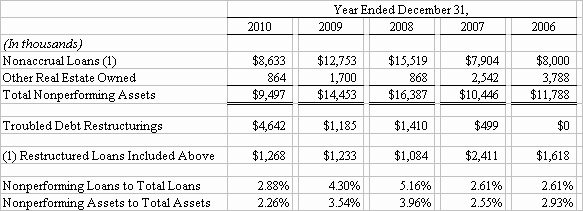
Other real estate owned, which is included in other assets, totaled $863,941, $1,700,280 and $867,507 at December 31, 2010, 2009 and 2008, respectively. The other real estate owned at December 31, 2010, consists of seven residential properties valued at $490,700, one commercial property recorded at $287,241, one vacant commercial lot recorded at $30,000 and two residential lots valued at $56,000. DBI acquired 11 properties during 2010 and sold 8 properties. The loss on the sale of the properties during 2010 along with write-offs on properties was $126,289. During 2010, DBI also incurred $456,966 of expenses associated with other real estate. These expenses consisted primarily of real estate taxes, repairs, insurance and legal.
The following table sets forth the maturities of various categories of loans (excluding loans held for sale) by primary collateral as of December 31, 2010:
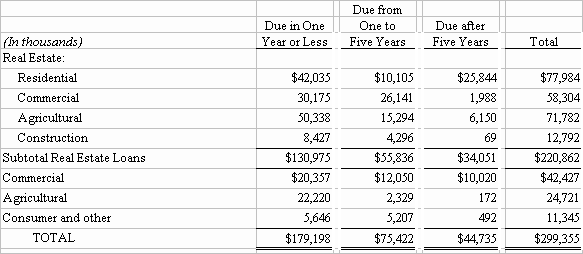
See Note 13 - Related Party Transactions in the Notes to Consolidated Financial Statements for information concerning aggregate loans to related parties.

47
MANAGEMENT'S DISCUSSION AND ANALYSIS
Allowance For Credit Losses
The allowance for credit losses is established through a provision for credit losses charged to expense. Loans are charged against the allowance for credit losses when management believes that the collection of the principal is unlikely. The allowance is an amount that management believes will be adequate to absorb losses inherent in existing loans and commitments to extend credit. The evaluations take into consideration a number of factors, including DSB's and DACC's loss experience in relation to outstanding loans and the existing level of the allowance for credit losses, changes in the nature and volume of the portfolio, overall portfolio quality, loan concentrations, specific problem loans, regular examinations and appraisals of loan portfolios conducted by state and federal supervisory agencies, and current and anticipated economic conditions. DBI applies risk factor percentages to certain categories of loans to estimate an appropriate allowance for loan and lease losses. Impaired loans are evaluated individually to determine an allowance related to those loans. The allowance for credit losses represents management's best judgment as to a prudent aggregate allowance in connection with the total loan portfolio.
At December 31, 2010, DBI's investment in impaired loans totaled $12,429,653 compared to $13,569,814 one year earlier. The impaired loans required a related allowance for credit losses of $1,403,161 at year-end 2010. Impaired loans are measured at the estimated fair value of the collateral.
In 2010 DBI's provision for credit losses was $1.2 million compared to $5.5 million and $1.0 million during 2009 and 2008, respectively. Net charge-offs were $0.6 million for the year ended December 31, 2010, compared to net charge-offs of $5.6 million and $0.5 million for the years ended 2009 and 2008, respectively. The ratio of allowance for credit losses to total loans was 2.29% at December 31, 2010, compared to 2.10% at December 31, 2009. The net increase to the allowance for 2010 was $0.6 million.
DBI's ratio of loans more than 30 days past due (including nonaccrual loans) to total loans was 3.04% at December 31, 2010, compared to 5.47% and 5.87% at December 31, 2009 and 2008, respectively.
DBI's portfolio is heavily concentrated in DSB's four-county primary service area and is subject to fluctuations in local economic conditions. DBI has a concentration of agricultural-related loans amounting to approximately 32% of total loans as of December 31, 2010. The factors that influence the agricultural economy are complex and difficult to predict. Management's underwriting practices takes these cyclical price fluctuations into consideration. Agricultural loans more than 30 days past due (including nonaccrual loans) totaled $115,635 at December 31, 2010. This represents 0.04% of total loans outstanding and 2.1% of DBI's total past due loans. During 2010 there were $26,782 of net recoveries on loans considered agricultural-related compared to $16,687 of net recoveries during 2009. Management does not believe that the risks associated with DBI's loan portfolio have changed materially during the past three years.
Management believes its allowance for credit losses as of December 31, 2010, of $6,864,497, or 2.29% of total loans, is appropriate to cover credit risks in the loan portfolio.
In 2010 DBI's ratio of charged-off loans to average loans outstanding was 0.29% compared to 1.98% and 0.34% during 2009 and 2008, respectively. During 2010, charge-offs declined $5.1 million or 85.5% from the charge-offs taken during 2009. The category of loans with the largest volume of charge-offs during 2010 was commercial real estate loans, with a total write-down of $367,137.
48
MANAGEMENT'S DISCUSSION AND ANALYSIS
Changes in the allowance for credit losses in each of the five most recent years were as follows:
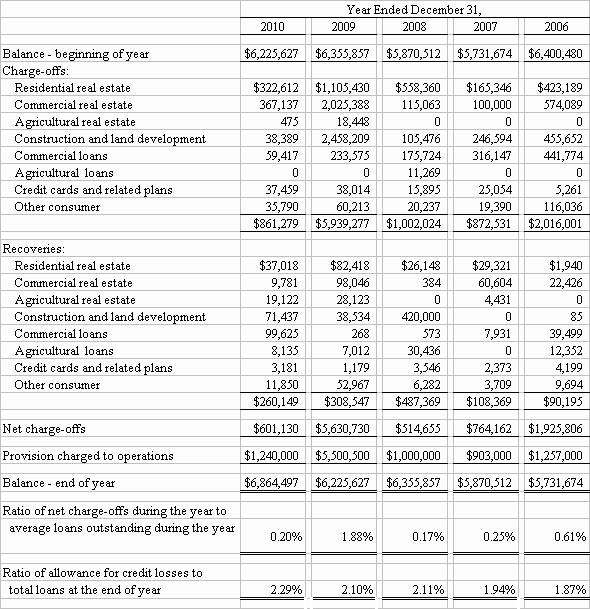
Deposits
At December 31, 2010, total deposits were $320.5 million, an increase of $14.0 million or 4.6% compared to December 31, 2009. Money market accounts increased $14.1 million or 14.1% over year-end 2009. The average cost of funds for money market accounts was 0.91% in 2010 compared to 1.09% during 2009. NOW account balances were $9.5 million or 46.6% higher at year-end 2010 as compared to the prior year-end. Savings accounts increased $2.5 million or 14.8% over the prior year-end. Non-interest bearing deposits increased by $0.9 million or 2.5% in 2010 compared to year-end 2009. Certificates of deposit decreased by $13.0 million or 9.8% in 2010 compared to year-end 2009. The average cost of funds for certificates of deposits was 2.17% compared to 2.92% one year earlier.
The following table shows, as of December 31, 2010, the maturities of time certificates of deposit in amounts of $100,000 or more:

49
MANAGEMENT'S DISCUSSION AND ANALYSIS
The following table shows the average balance and rate paid on deposits for each of the three most recent fiscal years:

The following table sets forth the deposits as of the end of each of the three most recent fiscal years and period-to-period percentage increases (decreases):

Investments
The investment portfolio is managed to provide liquidity and a stable source of income. Securities are purchased and designated as available-for-sale to provide liquidity to meet loan growth or deposit withdrawals. Purchases of taxable securities are limited to maturities or average lives of ten years or less while purchases of securities issued by state and local municipalities generally have maturities of 15 to 19 years and some protection against early calls (usually around 10 years). These purchases are made to take advantage of upward sloping yield curves that reward long-term investors with higher interest rates and favorable interest rate spreads compared to U.S. Treasury and U.S. Agency securities. No securities are purchased for trading purposes.
Investment balances in various categories at the end of the last three years were as follows:

During 2009 three mortgage-backed securities secured by non-traditional mortgage products were downgraded. These securities were analyzed by a third party to determine whether they were other-than-temporarily impaired and if so, if any credit loss existed. Two of the three holdings were determined to have other-than-temporary impairment and credit losses of $312,716 that were recorded through the income statement in the first quarter of 2009. During 2010, the three securities were evaluated on a quarterly basis. One of the two other-than-temporarily impaired securities was found to have additional credit loss during the year. DBI realized losses of $119,772 through the income statement as of December 31, 2010. DBI will continue to closely monitor the performance of these securities. Note 3 - Investment Securities contains additional detail on the evaluation process.
50
MANAGEMENT'S DISCUSSION AND ANALYSIS
The following table shows the maturities of investment securities at December 31, 2010, and the weighted average yields of such securities:

Yields on tax-exempt securities have been computed on a fully taxable equivalent basis, assuming a Federal income tax rate of 34%. Mortgage-backed securities are allocated according to their expected prepayments rather than their contractual maturities. Securities available-for-sale and securities held-to-maturity are combined in the table presented above.
Other Borrowed Funds
At December 31, 2010, total borrowings decreased $5.2 million or 11% compared to the previous year-end. DBI utilizes a variety of short-term and long-term borrowings as a source of funds for DBI's lending and investment activities and for general business purposes. DBI has in place asset/liability and interest rate risk guidelines that determine in part whether borrowings will be short-term or long-term in nature. At December 31, 2010, DBI had $105.5 million of established lines of credit with $61.9 million in availability. Note 9 - Long-Term Debt of the Notes to Consolidated Financial Statements contains information concerning the significant terms of the long-term borrowings.
During 2010, borrowings from the FHLB declined from $30.9 million as of year-end 2009 to $23.2 million. Federal Home Loan Bank (FHLB) advances and notes payable to banks consist of secured borrowings under existing lines of credit.
DACC's primary sources of funding are short-term and long-term notes payable to banks. As of December 31, 2010, DACC had established lines of credit of $30.0 million, of which $12.9 million was drawn in the form of short-term notes payable and $6.5 million in long-term notes payable.
DBI had an advance of $1.0 million outstanding during all of 2010 against its $6.0 million line of credit. This draw was done as of December 30, 2009 to fund the transfer of a foreclosed property valued at $1.0 million to DBI Properties, Inc. There were no draws made during 2010.
The following sets forth information concerning other borrowed funds for DBI during each of the last three years:
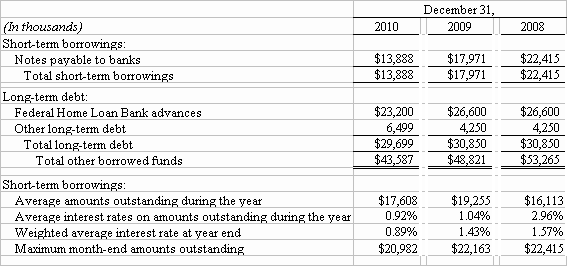
51
MANAGEMENT'S DISCUSSION AND ANALYSIS
Capital Resources
Stockholders' equity at December 31, 2010, increased 5.5% to $53,925,824 or $453 per share, compared to $51,103,648 or $431 per share one year ago. Cash dividends of $14.50 were declared in 2010, 2009 and 2008. The dividend payout ratio (dividends declared as a percentage of net income) was 50%, 196% and 46% in 2010, 2009 and 2008, respectively.
Pursuant to regulations promulgated by the Federal Reserve Board, bank holding companies ("BHC's") with total assets above $500 million are required to maintain minimum levels of core capital as a percentage of total assets (leverage ratio) and total capital as a percentage of risk-based assets. Under these regulations, the most highly rated BHC's must meet a minimum leverage ratio of at least 3%, while lower rated BHC's must maintain a ratio of at least 4%. The regulations assign risk weightings to assets and off-balance sheet items and require a minimum risk-based capital ratio of 8%. At least half of the required 8% must consist of core capital. Core capital consists principally of shareholders' equity less intangibles, while qualifying total capital consists of core capital, certain debt instruments and a portion of the allowance for credit losses.
The table set forth below describes the ratios of DBI as of the end of the three most recent years, and the applicable regulatory minimums.

The payment of future dividends by DBI is subject to the discretion of its Board of Directors and will depend on many factors, including DBI's operating results, financial condition and capital position. The ability of DBI to pay dividends on the Common Stock is largely dependent upon the ability of DSB to pay dividends on the stock held by DBI. DSB's ability to pay dividends is restricted by both state and federal laws and regulations. DSB is subject to policies and regulations issued by the FDIC and the Division, which, in part, establish minimum acceptable capital requirements for banks, thereby limiting the ability to pay dividends. In addition, Wisconsin law provides that state chartered banks may declare and pay dividends out of undivided profits but only after provisions have been made for all expenses, losses, required reserves, taxes and interest accrued or due from the bank. Payment of dividends in some circumstances may require the written consent of the Division. Note 17 - Regulatory Matters of the Notes To Consolidated Financial Statements contains information concerning capital ratios of DSB. Management has agreed with regulators to maintain DSB's leverage ratio at a level equal to or exceeding 8% and its risk-based total capital ratio equal to or exceeding 10%.
Management believes that 2011 earnings of DSB will be sufficient to pay dividends to DBI. DBI could also receive dividends from DACC, which has the earnings and capital strength to provide additional dividends to DBI. During 2010, DBI received dividends of $1.0 million from DSB and $862,500 from DACC. DACC had net income of $0.6 million, $0.7 million and $0.8 million for the years ended December 31, 2010, 2009 and 2008, respectively. The core capital as a percent of risk-based assets ratio of DACC as of December 31, 2010, was 29.0%.
Liquidity and Off-balance Sheet Arrangements
Liquidity refers to the ability of DBI to generate adequate amounts of cash to meet DBI's needs for cash. Loan requests typically present the greatest need for cash but liquidity must also be maintained to accommodate possible outflows in deposits. During 2010, net cash provided by operating activities which amounted to $5.0 million and the proceeds from the maturity or sale of securities of $24.3 million, as shown in the Consolidated Statements of Cash Flows, provided the major sources of funding. The $14.8 million increase in federal funds sold, the $5.2 million net decrease in borrowings and the payment of $1.7 million in dividends were the major uses of cash during 2010.
DSB maintains liquid assets to meet its liquidity needs. These include cash and due from banks, marketable investment securities designated as available-for-sale and federal funds sold. DSB also has the ability to borrow approximately $10.0 million by means of the purchase of short-term federal funds from its principal correspondent banks. Management strives to maintain enough liquidity to satisfy customer credit needs, meet deposit withdrawal requests and any other expected needs for cash. Excess liquid assets are reallocated to achieve higher yields. One ratio used to measure the liquidity of banking institutions is the net loan to deposit ratio. The net loan to deposit ratio of DSB was 84%, 86% and 87% at December 31, 2010, 2009 and 2008, respectively. A high net loan to deposit ratio creates a greater challenge in managing adverse fluctuations in deposit balances and consequently this can limit growth. The net loan to deposit ratio reflects only on-balance sheet items. Off-balance sheet items such as commitments to extend credit and established borrowing lines of credit also affect the liquidity position.
52
MANAGEMENT'S DISCUSSION AND ANALYSIS
In order to increase available funding sources DSB is a member of the Federal Home Loan Bank of Chicago ("FHLB"). As of December 31, 2010, the amount owed to the FHLB was $23.2 million. The borrowings are secured by residential mortgages. The maximum amount of collateral that can be pledged to FHLB by DSB is limited by state law to four times capital. DSB could borrow an additional $20.0 million from the FHLB based on its $3.6 million investment in FHLB common stock and eligible collateral. DSB also sells loans to DACC and to the secondary mortgage market to improve its liquidity position. During 2010 DSB sold $26.6 million of residential loans to the secondary mortgage market. In 1999, a $20.0 million line of credit was established with the Federal Reserve Bank. To date, DSB has not borrowed against this line. Other sources of liquidity consist of established lines of credit by DACC and by the parent DBI. As of December 31, 2010, DACC has unused lines of credit of $10.6 million and the parent company has an available line of credit of $5.0 million. See Note 12 - Commitments and Credit Risk in the Notes To Consolidated Financial Statements for a discussion of DBI's commitments to extend credit. As of December 31, 2010, DBI has no off-balance sheet arrangements other than the commitments to extend credit and the standby letters of credit disclosed in Note 12. Management believes DBI's liquidity position as of December 31, 2010, is adequate under current economic conditions.
Interest Sensitivity
The following table shows the repricing period for interest-earning assets and interest-bearing liabilities and the related gap based on contractual maturities, at December 31, 2010:

Mortgage backed securities are allocated according to their expected prepayments rather than their contractual maturities. For purposes of this analysis, NOW, savings and money market accounts are considered repriceable within six months. The above gap analysis is used to identify mismatches in the repricing of assets and liabilities within specified periods of time or interest sensitivity gaps. The rate sensitivity or repricing gap is equal to total interest-earning assets less total interest-bearing liabilities available for repricing during a given time interval. A positive gap exists when total interest-earning repricing assets exceed total interest-bearing repricing liabilities and a negative gap exists when total interest-bearing repricing liabilities exceed total interest-earning repricing assets.
53
EMPLOYEES OF DENMARK STATE BANK
|
Debra K. Ausloos Carol M. Behringer Christina M. Bienapfl Melissa S. Brandes Mary B. Buresh Sheena M. Craanen Terese M. Deprey Hilaria A. Dose Mary J. Doucha Lynnette E. Duckett Donna P. Emmer Beverly J. Evenson Jill S. Feiler Sara L. Fels Joanna B. Fischer Bonita M. Gauger Patricia A. Gremore Sara J. Halfmann Dennis J. Heim Tim L. Henke Kristine C. Hernandez Kevin W. Johnsrud Donna J. Kafka Melissa M. Kersten Betty A. Kittell Ellen M. Klarkowski Kim M. Kohn Linda L. Kolarik Ann M. Kozlovsky Lawrence J. Kozlovsky Evonne J. Kreft Carl T. Laveck Lynda A. Leanna Julie A. Lemmens Lonnie A. Loritz Stacy L. Magnuson Rachel J. Markvart Sandra R. Miller Shawn E. Mueller Kristina L. Nelsen Stephanie M. Nemetz Sarah L. Neuser Tamara A. O'Brien
|
Denmark John P. Olsen Tobias H. Olsen Anna M. Pearson Stephen N. Peplinski Tammy A. Pribyl Charles J. Rabitz Bonnie L. Reindl Linda M. Rentmeester Sarah J. Schley Diane M. Schlies Kenneth J. Schneider Cynthia L. Shimon Lori A. Sisel Jeanne M. Swagel Kimberly J. Tess Deanna L. Tilot Jeffrey G. Vandenplas Samantha M. Van Elzen Allison J. Van Groll Leroy M. Verkuilen Cynthia M. Winiecki Jeanne L. Wolf Michelle R. Wotachek
Bellevue Brenda M. Allen Mary A. Bauer Molly J. Carriveau Joan M. DeGrand Jodi G. Havlovitz Amy R. Hertel Amanda J. Jacquart Ryan M. Johanek Chad R. Kofler Mary E. Kropp Brittney M. Tollar
|
Maribel Edwin R. Duckart Debbie A. Grenier Linda M. Kuik Tami J. Pelischek
Reedsville Linda L. Beyer Joan C. Popp Sara J. Ebert Darlene F. Schmieder Gail S. Wegner
Whitelaw Debra J. Habeck Deborah L. Kopidlansky David H. Radue Richard J. Schmieder Bonnie M. Vogel Kristine Weber
Wrightstown Tiffany L. Allen Polly L. Novitski Katherine R. Wilson
|
54
DIRECTORS AND OFFICERS
|
Directors of Denmark Bancshares, Inc. |
Officers of DBI and DSB |
|
|
Janet L. Bonkowski Public Relations Manager Schneider National, Inc. Director of Denmark State Bank Thomas N. Hartman President Hartman's Towne and Country Greenhouse, Inc. Director of Denmark State Bank Michael L. Heim President Heim Trucking Company Director of Denmark State Bank Kenneth A. Larsen, Sr. Sole Member, K.A. Larsen Consulting, LLC Director of Denmark State Bank William F. Noel Operations Manager St. Bernard & St. Philip Parishes Director of Denmark State Bank John P. Olsen* CEO and President of Denmark Bancshares, Inc. CEO of Denmark State Bank Director of Denmark State Bank Diane L. Roundy Director of Business Development Schenck Business Solutions Director of Denmark State Bank Thomas F. Wall* Chairman of the Board of Denmark Bancshares, Inc. Retired Sales Account Manager Natural Beauty Growers Director and Chairman of the Board Denmark State Bank
|
John P. Olsen* CEO and President of Denmark Bancshares, Inc. CEO of Denmark State Bank Director of Denmark State Bank Jill S. Feiler* President of Denmark State Bank Vice President and Secretary of Denmark Bancshares, Inc. Carl T. Laveck* Executive Vice President of Denmark Bancshares, Inc. Executive Vice President and Chief Credit Officer of Denmark State Bank Dennis J. Heim* Vice President and CFO of Denmark Bancshares, Inc. Sr. Vice President and CFO of Denmark State Bank Lonnie A. Loritz* Vice President and Secretary Denmark State Bank David H. Radue Vice President Denmark State Bank Kimberly J. Tess* Assistant Vice President and Controller Denmark State Bank Jeffrey G. Vandenplas Vice President Denmark State Bank
* Executive officer |
55
QUARTERLY FINANCIAL INFORMATION
MARKET INFORMATION
The following table shows market price information and cash dividends paid for DBI's common stock:

- The Common Stock of DBI trades sparsely. There is no established market for the Common Stock of DBI and it is unlikely that such a market for the shares will develop in the foreseeable future.
- The ability of DBI to pay dividends is subject to certain limitations. See "Capital Resources" in Management's Discussion and Analysis.
As of February 22, 2011 DBI had 1,614 shareholders of record. Beneficial owners of DBI's Common Stock whose shares are held in "nominee" or "street" name are not included in the number of shareholders of record.
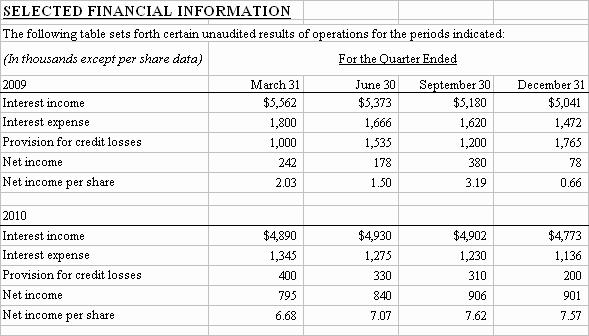
56
